Since August 2020, PAD has collaborated with the International Fund for Agricultural Development (IFAD), a UN affiliated multilateral agency, to deliver digital advisory to assist smallholder farmers in Kenya, Nigeria and Pakistan to boost productivity and resiliency as they navigate the evolving impacts of the COVID-19 pandemic.
On 05 May 2021, IFAD convened an #IFADinnovationtalk webinar to showcase our partnership under the auspices of presentations and a panel discussion entitled ‘Digital Agriculture and the Rural Poor: Challenges and opportunities in delivering results’. Keynote speeches were delivered by Michael Kremer, PAD co-founder and Nobel Prize winner, and Owen Barder, PAD CEO. Our colleague Uzoamaka Ugochukwu, Nigeria Country Launch Manager, participated in a panel with Vivian Hoffman (a PAD research partner at IFPRI) and Dr. Zahoor-ul-Hassan (a key champion of our work in the Government of Punjab, Pakistan), and Patrick Habamenshi (country manager of IFAD Nigeria).
As Owen Barder, PAD’s CEO, stated in his keynote address, our collaboration with IFAD has demonstrated:
First, that our services can be replicated, adapted and scaled in new geographies, and can be scaled up to new target populations in existing geographies;
Second, that we have been able to develop and deploy surveys and A/B tests to quickly and accurately gather and analyze information from users to improve our services and adapt to evolving challenges in near real time; and
Third, the combined capabilities of governments, multilateral organizations and non-profit service delivery organizations can deploy services quickly and at scale, using local talent and shared knowledge and systems.
The full text of Michael Kremer’s contribution is accessible here; Owen Barder’s speech can be accessed here; and a full recording of their presentations, panel discussion and subsequent Q&A is accessible via the video posted at the top of this page.
We envisage this our partnership with IFAD as both a mechanism for recovery from the devastating effects that the COVID-19 pandemic has had on smallholder farmers, and an investment in better ways of delivering agricultural information in the long term.
We are excited at our progress in advancing our systems to complement IFAD’s work in support of poor rural farming families and look forward to further success as we continue to work together to service poor, rural families with valuable and productive information.
Owen Barder, CEO
Sam Carter, Revati Vaidya, Simon Rubangakene, Georges Poquillon and Habtamu Yesiget recount how we improved our content and services by learning about our end-users response to messages recorded with men’s voices and women’s voices.
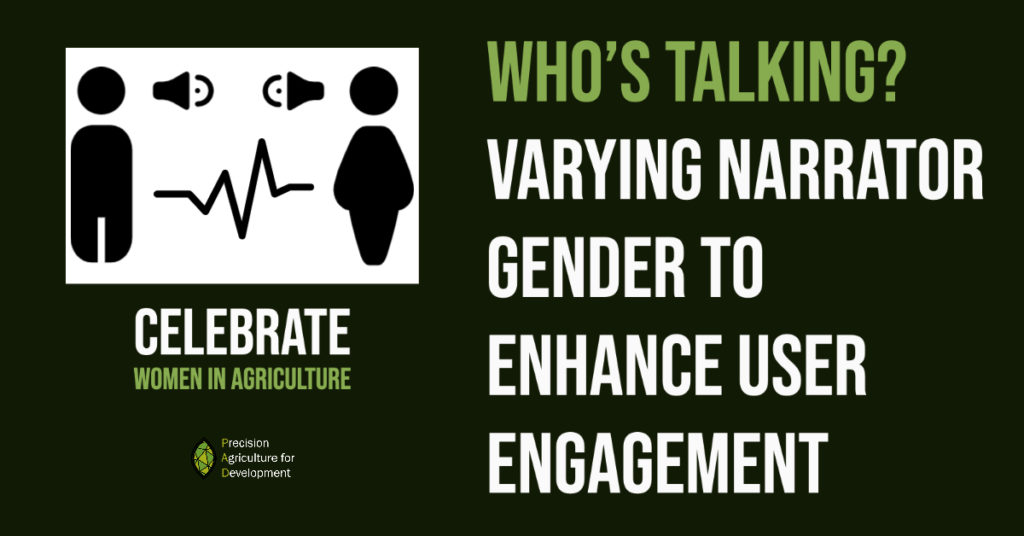
Do farmers act differently when they hear a woman’s voice giving them agricultural advice? How much does this matter in the nine different countries where we operate? These are questions we often ask ourselves since interactive Voice Response (IVR) and push calls are the bread and butter of our outreach to smallholder farmers.
Rigorous research is in our DNA, since PAD was born out of a study proving that mobile-phones can cheaply deliver actionable agricultural advice to farmers. We routinely test and evaluate different versions of our service to identify the best way to engage farmers with our services and, ultimately, turn our advice into action. We’ve tested the length of voice calls, the order in which menu options are presented, and use of urgent language in our messages among many others.
In Uganda, Ethiopia, and India, PAD has conducted A/B tests to understand whether the gender of the person narrating the advisory content has an impact on farmers’ pick-up and listening rates. In Uganda, we found that switching from a male to female narrator increased farmers’ engagement with PAD content, and as a result, we will use a female narrator for all new content developed for that program. In Ethiopia, on the other hand, we found that both pick-up and listening rates were higher when content was voiced by a male narrator than a female narrator. Meanwhile, in the Indian state of Gujarat, we found no statistically significant difference in engagement rates based on the gender of the narrator. Taken together, these results suggest the need for a nuanced, contextually-grounded approach to understanding the role that the narrator’s voice plays in determining farmers’ engagement with our service.
This blog post presents a summary of each experiment design and its results, and teases out the implications of these results in time and place:
Uganda
Simon Rubangakene, Project Associate and Georges Poquillon, Senior Research and Operations Manager
PAD’s service in Uganda
In Uganda PAD delivers digital training to smallholder farmers as part of an initiative run by Uganda Coffee Agronomy Training (UCAT) – a program implemented by the non-profit organizations Hanns R. Neumann Stiftung and TechnoServe – which delivers training to approximately 60,000 farmers in western Uganda via Farmer Field Schools. UCAT aims to train farmers to implement Good Agronomy Practices (GAPs) to increase yields and – by association – livelihoods.
PAD provides digital training to 4,000 UCAT farmers who are participating in a randomized evaluation in which farmers receive standalone and reinforcement training. The evaluation intends to understand the impact of varied approaches to agronomy training and/or extension services.
PAD’s digital advisory is pushed to farmers’ mobile phones in four different languages (English, Luganda, Runyankole and Rutooro). Standalone farmers who are not part of the UCAT program are also able to call in and record questions, which are answered by an agronomist within 48 hours. Standalone farmers and those attending training run by Hanns R. Neumann Stiftung receive IVR calls on a weekly basis, whereas farmers attending training run by TechnoServe receive advisory messages once a month.
How the A/B test varied the gender of the narrator, and why we decided to test this question
Prior to this A/B test, PAD’s advisory service in Uganda included content delivered by both male and female narrators. Due to the way in which language-use was distributed, few farmers receiving advisory from PAD were receiving advice voiced by a female narrator which made it difficult to identify listening patterns linked to voice. The Uganda team decided to implement an A/B test to better understand how farmers’ listening rates varied based on the voice of the narrator.
The study ran for eight weeks, from October 14, 2020 to December 9, 2020, a time coinciding with the runup to, and active period of the coffee harvest in Uganda. For this A/B test, we randomly assigned the 4,009 UCAT farmers receiving advisory from PAD to one of two groups. Group 1 (2,004 farmers) received content voiced by a narrator whose gender did not match their own. Group 2 (2,005 farmers) received content voiced by a narrator of the same gender. We stratified the sample to ensure that both groups were balanced in terms of language and the organization implementing the in-person training.
Results of this A/B test
Switching the message content from being voiced by a man to being voiced by a woman positively and sustainably increased the probability that female farmers picked up IVR calls, while there was no effect on the likelihood of a male farmer taking a call. With regard to the propensity to listen to most of the IVR call content, switching from a female to a male narrator reduced the listening rate of male farmers, while the opposite held true when switching from a male to a female narrator. However, the effect on the male completion rate was found to be lower over time. In the case of female farmers, switching from a male to a female narrator increased the likelihood that they listened to most of the message, with more long-lasting effects.
The findings suggest that both male and female UCAT farmers are more sensitive to messages voiced by a female narrator. However, the short-term nature of some effects may prevent such a change from generating long-run changes in farmers’ engagement. Moreover, only two narrators of each gender were involved in the recording, so we cannot rule out the possibility that we are capturing a “narrator” effect rather than a gender effect.
Implications for programming and future research
A direct consequence of the findings of this study is that the new UCAT content will be entirely voiced by female narrators. Farmer engagement following the introduction of this new content will be monitored to assess whether any change arises, leading to improved listening and completion rates.
Ethiopia
Habtamu Yesigat, Director of Programs, Ethiopia
PAD’s service in Ethiopia
PAD has collaborated with the Ethiopian Agricultural Transformation Agency (ATA) since 2017 to measure and improve the effectiveness of ATA’s 8028 farmers’ hotline service. The 8028 farmers’ hotline, introduced in 2014, is an IVR service available in five languages which has reached more than 5.4 million farmers. A farmer can call into 8028 – free of charge – and navigate through different menus to reach advisory content on 21 crops and four livestock commodities.
How the A/B test varied the gender of the narrator, and why we decided to test this question
Historically, the 8028 farmers’ hotline content has been narrated by a female journalist. In an international benchmarking study that PAD carried out in 2018, we realized that inbound systems in other settings had tested a variety of techniques to attract more farmers to call in and to encourage users to listen longer. Varying the narrator of the agricultural content (for example, varying the gender of the narrator, varying whether the narrator is a journalist or a subject matter expert, or using the voices of celebrities, agriculture leads, and scientists) is among these strategies.
The evaluation covered 462,000 farmers enrolled on the 8028 farmers’ hotline service and ran during Ethiopia’s primary rainy season in 2019 (June through August). Farmers who participated in the study were growing a variety of crops including wheat, maize, malt barley, sesame, and teff. At the beginning of the study, each farmer was randomly allocated to one of the three treatment arms, and received a series of push calls throughout the season to provide relevant to the farmer’s crop and location.
The three treatment arms were: female journalist narrator, male journalist narrator, and a male agronomist narrator. The study assessed whether there was a difference in the average time a caller spent listening to the service when we changed the gender and profile of the narrator. However, because there was no treatment arm with a female agronomist narrator, we were not able to fully understand the interactions between the perceived gender and expertise of the narrator.
Results of this A/B test
Both the pick-up rate (proportion of farmers who picked up the phone) and listening rate (proportion of the call duration to the total length of the content) were higher for the male journalist narrator and the male agronomist. We saw no significant difference in pick-up or listening rates when comparing between the male journalist and the male agronomist.
| Female journalist | Male journalist | Male agronomist | |
| Pick up % | 33.9% | 34.3% | 34.5% |
| Listening % | 87.4% | 92.3% | 92.2% |
With this evidence, and acknowledging the fact that we didn’t have a female agronomist voice as a treatment arm, we can only speculate as to the mechanisms driving the higher engagement rates for male voices. There is a socio-cultural association between agriculture and men which may contribute to the difference. In addition, we did not include a treatment arm featuring a female agronomist; it may be the case that farmers were more interested in listening to an agricultural expert rather than a female journalist, but that they would have been equally receptive to a female agronomist.
Implications for programming and future research
This evaluation has helped us to think about the multiple factors that must be considered when evaluating a change to the narrator’s voice. When we next implement an outbound call service in Ethiopia (which we will likely do in the next few months), we plan to repeat this experiment with the additional confounding factors in mind.
Gujarat, India
Revati Vaidya, Process and Product Innovation Associate
PAD’s service in Gujarat, India
The Indian state of Gujarat is home to PAD’s oldest program, which began operating in 2016. The service, called Krishi Tarang ( “agriculture wave” or “vibe” in Gujarati and Hindi) currently serves over 36,000 farmers. Krishi Tarang provides farmers with free, customized information in two ways: i) weekly voice messages are pushed to enrolled farmer’s mobile phones (“outbound” service), and ii) farmers have the ability to call into an IVR hotline to record a question and access other information (the “inbound” service). Messages recorded by farmers via the hotline are answered by agronomists via push call within 48 hours. Traditionally, calls from Krishi Tarang have been narrated by a male voice.
How the A/B test varied the gender of the narrator, and why we decided to test this question
At the beginning of the 2016 Kharif season, PAD implemented an evaluation to test four different narrator voices to see how they impacted farmers’ listening rates. Approximately 3,000 farmers, who were registered as Krishi Tarang users at the time, were each assigned to receive calls from one of four different narrators: a male agronomist (who identified himself as an agronomist during the recording), a farmer (generally male, who identified himself as a farmer during the recording), male voice (no occupational emphasis), or a female voice (no occupational emphasis).
This A/B test took place over four weeks during Kharif, from the end of May to the 21st of June, 2016.
Results of this A/B test
No statistically significant differences were observed among the listening rates across the four groups (i.e four voices). No one voice emerged as the best choice.
Implications for programming and future research
Given that there were no statistically significant differences in listening rates observable across the four voices, no changes were made to the service.
Quo Vadis?
To recap: in Uganda, switching from a male narrator to a female narrator led to higher engagement, while in Ethiopia, the opposite was true. In Gujarat, there were no significant differences based on either the gender or the stated expertise of the narrator.
From a social science perspective, these results underline the extent to which gender is a social construct bound by time and place. Gender dynamics are highly context-specific, and findings cannot easily be generalized from one setting to another. The association between a narrator’s gender and their perceived expertise is just one of many important questions that we, as researchers, must try to understand before drawing firm conclusions about the role of the narrator’s gender on listening rates within a given population. At a more general level, these diverging results reinforce the importance of local learning and local knowledge, and the importance of customizing our services and information in situationally-appropriate ways (see for example our recent blog post on more intentionally understanding the needs of female farmers in the Kenyan dairy sector).
From an implementation perspective, these results demonstrate the value of collecting data on the gender of PAD users to improve both individual customization and overall program design. However, collecting detailed information on user characteristics involves important tradeoffs: We need to ask more questions of farmers to deliver personally-tailored services, yet asking too many questions will lead some farmers to drop off. Other farmers may balk at perceived privacy implications. Moreover – as detailed in another recent blog post – in smallholder households, mobile handsets are often shared among adults, so we are not always sure whether the person answering the phone is the person whom we have profiled.
As PAD continues to emphasize gender in our research and program implementation, we anticipate wrestling with difficult questions. For example, what if we find that behavior change is more likely to occur when our content is delivered in a way that reinforces patriarchy or other existing social prejudices (e.g., a narrator whose accent is associated with a particular social class or privileged group)? On the other hand, we have also begun to consider whether our service might be able to specifically target social biases based on gender and other characteristics. For instance, we might test two versions of a message delivered by a female narrator: one that includes an introduction highlighting the narrator’s technical skills, and one that doesn’t, to understand whether emphasizing the narrator’s qualifications might generate additional behavior change.
Theresa Solenski, PAD Global Research and Program Associate, reflects on the growing body of gender-focused evidence – generated by the field at large, and by colleagues at PAD – we can exercise to inform evidence-based interventions to improve the lives of women.
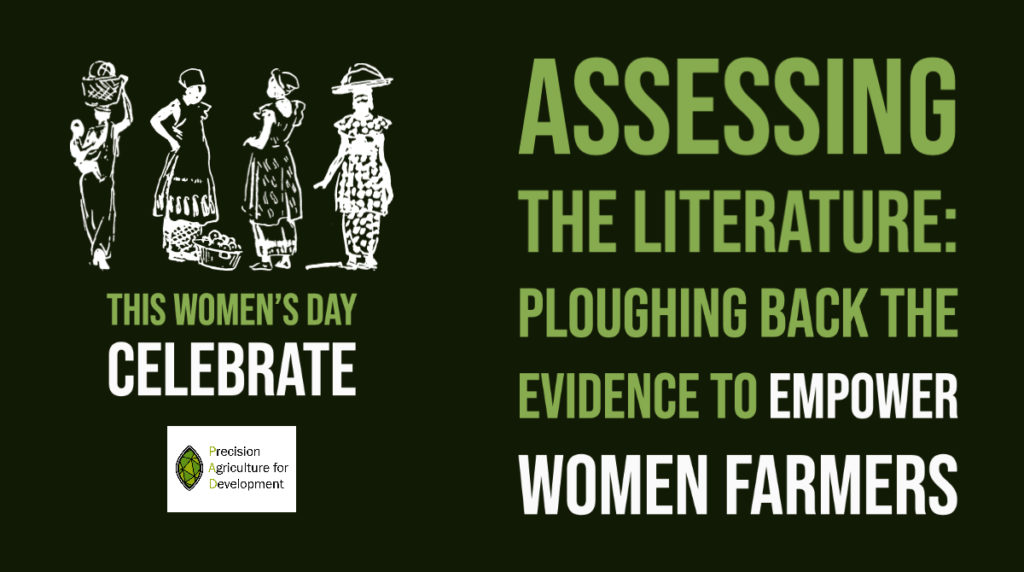
As we mark International Women’s Day, this blog post will reflect upon and celebrate the growing evidence-base of gender-focused research that is intended to inform evidence-based policies and laws to improve the lives of women. Experimental interventions and gender-focused surveys help to illuminate the unique barriers women face as women and reveal which solutions are most impactful for empowering women and reducing poverty. These interventions and their learnings provide a foundation for future policy work wherein positive impacts are replicated and iterated to benefit women in other contexts.
Much research has already been done at the intersection of gender and agriculture in developing countries, some by my colleagues and collaborators at Precision Agriculture for Development. Researchers know that women farmers confront various constraints (for example, constrained access to land, inputs,and finances) that are significantly different and usually more onerous than those faced by their male counterparts. Addressing these constraints can unleash significant agricultural productivity, to the benefit of households and communities more generally. For example, researchers know that women under-invest in plots when their land rights are not secure. In a study of a land tenure regularization program in Rwanda, investments in soil and water conservation (which are critical given the intensive use of land in Rwanda) increased by approximately 10 percentage points for male-headed households, but for female-headed households, these investments increased by almost twice as much (Ali et. al., 2014). One policy implication we can draw from this research is that strengthening women’s land rights can lead to larger per plot investments.
We also know that there is significant evidence that women face labor constraints when it comes to their agricultural productivity. Contributing factors include cultural norms which dictate that women should tend to children and the home, and constraints on women’s access to finances to hire labor or access labor-saving technologies (such as machines or animals). These types of gendered labor constraints can impact policy to the extent that some well-intentioned gender-sensitive interventions have had the negative effect of increasing women’s time poverty (Quisumbing & Pandolfelli, 2010). Taking these considerations into account, female-targeted interventions will be most productive when they focus on high impact behaviors and practices – those that produce significant gains in productivity with little or no increase in labor intensity.
Other research has focused on complicated intra-household dynamics that play a role in the empowerment and wellbeing of females in male-headed households. In particular, while women play a significant and active role in agricultural production, data reveals that they exercise decision-making authority on fewer activities than male-heads of household. An example is that husbands often make financial decisions without consulting their wives. Due to cultural norms, men are also often the ones who go to the market to both buy agricultural inputs and sell crop yields. This household dynamic frames an environment in which women are both unable to exercise decisions that impact their standard of living, and are unable to capture many of the gains associated with their labor despite their significant – often disproportionate – contribution to household production.
Interventions that target women with agricultural extension services can increase their agricultural decision-making ability in the household. A study of maize farmers in Uganda found that women who received agricultural information (either alone or jointly with their spouse) reported large, statistically significant increases in their decision-making ability (Lecoutere et. al., 2020). The same study found that in households where women were involved in receiving agricultural extension advisory, adoption and input use indices were statistically larger than those in the control group.
Moreover, research demonstrates that increasing women’s decision-making ability in agricultural tasks can lead to improved wellbeing. A study of dairy farmers in Uganda found that greater decision-making input on the part of women farmers into dairy production reduces women’s time poverty. The researchers’ model shows that women’s input in dairy production was likely to reduce women’s time poverty by approximately 97 per cent when they had some input (Bain et. al., 2018). This evidence is encouraging, and suggests that not only can agricultural information empower women farmers by increasing their decision-making abilities, but that this empowerment can improve productivity and wellbeing.
PAD functions both as a research generator and as an implementer of gender-focused learning. For example, PAD has developed a gender survey which measures time-use, financial decision-making, and gendered task-allocation among dairy farmers in Kenya. The survey deploys an innovative public goods game which is played by spouses as means for measuring trust and communication, and to reveal intra-household dynamics. The findings from this survey – which is currently being implemented – will be used to inform our Kenya dairy program, other programs like it, and will contribute to the literature on the influence of gender in dairy farming.
In its role as implementer, PAD has developed content to specifically address the needs of female farmers and we mass-disseminate this content via mobile phones. For example, in Odisha, India, we send messages focussed on the cultivation of kitchen garden to approximately 60,000 women. These messages cover content on crops in a domain that is typically under a woman’s decision-making purview. Messages were field-tested with women focus-groups and the advisory highlights the benefits of maintaining a kitchen garden, compost preparation, cultivation of crops, pest and disease management, and the nutritional value of kitchen garden crops. Our kitchen garden messages have received higher ratings than our regular Ama Krushi messages (4.2/5 vs 4/5) and women have indicated a strong preference for the kitchen garden content (87 percent of women reported a preference for the kitchen garden content over the traditional Ama Krushi messages).
Much work remains to be done. One challenge we face is to effectively target and communicate with female farmers through mobile phones. Globally, women are less likely to have access to the internet, to own their own phone, and to be literate (OECD, 2018; Baroni et. al., 2018). In order to effectively reach women, mobile interventions must be sensitive to these constraints, providing resources in mediums that women understand (for example, voice services rather than SMS and using local dialects where applicable). A further complicating factor is that many smallholder households only have one cell phone with all adults in the household sharing one device. As a consequence, the gender of the person on the receiving end of our service is often unclear. This can result in gender misclassification wherein the person who registered with our service is not necessarily the same person who engages with the platform. Moreover, PAD currently collects gender-related data in only half of its programs. However, we are committed to collecting gender data from all programs where feasible and to conduct quality checks when gender misclassification is suspected.
Experimentation and heterogeneity analysis inform our gender programming in contexts where we have gender data, and this allows us to iterate evidence-based programming to make it progressively more impactful in women’s lives. For example, in Uganda, PAD’s team has used A/B testing to more effectively understand whether matching the gender of the narrator’s voice [in an automated IVR call] with the gender of the recipient increases engagement with the platform. Results indicated that women listeners who switched from receiving calls with a male narrator to a female one, were almost 2 percent more likely to complete a call. Based on this evidence, future content in Uganda will be narrated by women.
We plan to continue on this path forward: leaning into the literature for guidance while generating and iterating the evidence-base through the use of A/B tests; focusing on developing and delivering high-impact content; improving intra-household coordination; and more effectively identifying and leveraging high-opportunity channels to communicate with women.
Maya Woser, Senior Research and Operations Associate, Stefania Pozzi, Global Senior Research Associate, and Yifan Powers, Global Senior Research Associate, pull on strands of evidence to assess the effects of patriarchal practices and cultures in the workplace and the effects of empowering women as role models and leaders, and concurrent effects for organizational development. The piece also integrates reflections from PAD colleagues Maureen Kuboka, Caitlin McKee, Claudia Carbajal Morelos, Sam Carter, Wafa Tahir, Maham Bokhari and Owen Barder.

Whether you live in the United States or India, the past 12 months have been a difficult time for women. The COVID-19 pandemic laid bare and exacerbated many structural inequalities and barriers that continue to make it difficult for women to fully participate in the workforce. It also highlighted the indelible value of women’s reproductive labor, which, in many respects, is the often invisible and unpaid work that allows our global economy to function. This is especially true for traditionally marginalized groups, as evidenced by the outsize impact of the pandemic on women of color in Western societies, and highlights the importance of intersectionality when thinking about how each society can best support women and families. Yet while the pandemic has shown how tenuous our progress in gender equality can be, it can also provide the momentum for profound change. As Arundhati Roy wrote, “the pandemic is a portal, a gateway between one world and the next” and we can take this opportunity, when everything seems broken, to move toward a new reality. In that spirit, and in honor of International Women’s Day, here are some reflections from staff at PAD on what factors, especially in the international development field, are important to consider when building a more gender equitable future.
Role Models
In a now seminal paper, Lori Beaman, Nobel Prize in Economics winner, Esther Duflo, Rohini Pande, and Petia Topalova found that while increasing the number of women in leadership positions in India did not impact structural labor market opportunities for young women, there was a strong, positive role model effect on young women’s perceptions of self-worth and the types of roles they could inhabit. The co-authors also found that increasing women representation in visible leadership positions changed the perception of others’- in this case parents – with regard to what girls can accomplish.
Beaman et al’s paper describes through rigorous experimental data an experience many women are personally familiar with – the profound impact of seeing women in positions of power and in positions they may not have been able to imagine themselves in before. In the workplace, particularly in traditionally male-dominated STEM professions such as economics, this means increasing the visibility of women through hiring, promotion, and keeping them in the workforce – not just in a few token leadership positions but systematically throughout an organization – can be crucial to closing the gender gap. Advancing gender equity is always going to be a work in progress and in the spirit of transparency, PAD can report that 40% of our current staff overall are women and about half of our management roles are occupied by women.
Reflections from PAD Staff
Maureen Kuboka, Agronomy Associate, PAD – Kenya
Why do you think having women as role models is important in the agronomy field?
It is important to have female role models in agronomy because they help you know that you can succeed in this male-dominated field. A role model or mentor can hold your hand and help you know how to make it. In my experience, they have challenged me and shown me that it can be done.
Have you ever had a woman as a role model or mentor, whether formal or informal, who impacted you in your career?
At my former workplace, I was inspired by the success of several senior female agronomists. I took that opportunity to observe and follow in their footsteps through “observational learning”. I am also still in touch with two senior lecturers who are women from my postgraduate degree and several of my former college classmates. We encourage one another in our respective fields of work and I am particularly challenged by college classmates who have been able to scale the ladder as well as those pursuing further education while they work. I am also keen to develop a formal relationship with a female mentor through the African Women In Agricultural Research and Development (AWARD) Fellowship.
How does having more women in the workplace make you feel about that workplace and does it change how you approach your work?
Having more women in the workplace makes me feel that women are being recognized and highlights how inclusivity is a powerful tool. It boosts my morale and feeling of having opportunities at work, as well as improves collaboration and teamwork. For example, I can comfortably share a personal issue with a female colleague and we can find a solution through discussing how they overcame a similar issue. I was elated by the recent appointment of Dr. Ngozi Okonjo- Iweala as the Directory-General of the World Trade Organization. She inspires me to picture myself as the next Director-General of the Food and Agriculture Organization of the United Nations (FAO).
Caitlin McKee, Global Research Support Manager
Why do you think having women as role models is important in academia/the development economics field?
As a woman, having a female role model in the workplace is important for your development, especially in navigating tricky decision points in your career trajectory like furthering your studies, switching jobs, or handling maternity leave. It’s also critical for shaping the lens through which you see your professional work. The perspectives of women, along with other minority perspectives, are critical to understanding the development economics field and identifying what kind of research questions to ask in the first place.
Have you ever had a woman as a role model or mentor, whether formal or informal, who impacted you in your career?
In graduate school at the University of Washington I worked for a research team led by Leigh Anderson and Mary Kay Gugerty. Despite incredibly busy schedules, these professors encouraged my learning, helped me develop critical skills, and pushed the bar of excellence for our work. There was also a gender-angle to much of the analysis that we did, not only on agricultural outcomes, but also on outcomes such as intra-household decision-making and time use, and they always emphasized the importance of gender-disaggregated data in any context. Their approach to crafting relevant research questions for women living in poverty reinvigorated me wanting to continue in the development field, using data as a tool to shed light on policy relevant questions.
How does having more women in the workplace make you feel about that workplace and does it change how you approach your work?
Workplaces are better with diversity of all kinds to bring different perspectives and experiences to doing the work itself and in setting organizational norms. Having more women in the workplace, especially in leadership and management positions, is an important part of that. At PAD I’m very pleased to get to report to our female Chief Economist and Director of Research, Tomoko Harigaya. Of the many reasons why I wanted to work for PAD, a solid group of women in leadership and management positions to work with closely was a very compelling reason.
Leadership
Despite progress in recent years in the number of women represented in leadership positions and in advances toward the achievement of equal opportunity, there are still strongly embedded gendered stereotypes about who a leader is. A study by Martin Abel found that both women and men react more negatively to criticism if it comes from a woman, and work by Gallup found that even women are more likely to report a preference for having a male boss compared to a female boss.
One explanation for these stereotypes may be actual differences in men’s and women’s leadership, but there is ongoing debate as to whether such differences exist. In a 2003 meta-analysis of 45 studies, Alice Eagly and Mary Johannesen-Schmidt found that women tend to use a more interactive style of management called transformational leadership, which emphasizes open communication, intellectual stimulation, and support for staff’s personal growth. The authors also found that women were more likely than men to deliver rewards to subordinates for appropriate performance. On the other hand, authors like Cliff, Langton, Aldrich and Andersen and Hansson claim that there are no significant gender differences in leadership styles. Another possible explanation is that these stereotypes originate from underlying beliefs, attitudes and mindsets about appropriate gender roles and behaviors: our expectations and gender biases might change the way we observe reality.
Either way, the presence of these stereotypes highlight the depth of challenges to women in leadership positions, especially those in traditionally male-dominated fields where the few women who make it to the top are often confronted with questions on their ability to lead. However, organizations can do a great deal of work that levels the field for women, principally by creating an environment that is free of discrimination and one in which talent can be evaluated on an individual basis and not according to latent gender stereotypes. This will not only grow the talent pool of potential leaders, but will also ensure that different perspectives are brought together to contribute to the multiple challenges society faces.
Reflections from PAD Staff
Claudia Carbajal Morelos, Regional Director for Latin America
What do you think are the most significant challenges that women leaders face in the development field?
Unfortunately and unsurprisingly, the challenges faced by women in the development field mirror those abroad in society. Here are three that are salient for me:
1. Credibility – I think when working with new people, women start out with a credibility deficit compared to their male peers. Women are placed with a greater burden of “proving” their credibility and need to exert more effort and be better prepared to earn an equal seat at the table.
2. Believing in yourself – Because society has conditioned women to doubt themselves more, or to exert less authority, women are more likely to caveat their perspectives or opinions. This can reduce the strength and effectiveness of their interventions. Women are also likely to question their qualifications when thinking of taking on new responsibilities. For example, men are more likely to apply to a position for which they don’t meet the criteria. Women are also more likely to volunteer for thankless or low-promotability tasks.
3. Speaking up – In my experience, women are less likely to speak up in meetings. This limits our influence and ability to recruit people to our ideas or initiatives.
Which piece of advice would you give to women who are trying to become leaders in the development field?
1. Find a mentor – Or find a few. Find people that share your vision and can help you advance your professional or personal goals. Recruit people that fully embrace your identity as a leader.
2. Be aware of internalized gender biases and how those affect your actions – It can be easy to fall into stereotypical attitudes or roles and it can be hard to identify those situations or actions. Find good resources that could help you understand what you are doing and how to change those behaviors. Be intentional with your actions and reflect on them frequently.
3. Trust yourself – Believing in yourself and your strengths is fundamental to applying your full self to your work. Identifying your weaknesses and working on them can be helpful, but don’t let that become your entire self-identity. Pay equal or greater attention to your strengths and leverage them widely.
4. Promote dialogue and diversity training in your workplace – Unfortunately, you don’t have control over how others’ biases affect you and you, alone, can’t change their net effect on your work. Actions on an individual level help, but action at an organizational-level is important to reduce the negative effects of bias.
Who inspired you and why?
I find Michelle Obama inspiring. She is a self-confident woman who stands up for what she believes in. She has fantastic communication skills that empower her to deliver complex messages to broad audiences. She is charismatic and has a strong character. She is perseverant and stubborn, while also compassionate. She is both privileged and well-grounded. She is relatable and accessible. I wished the world had more Michelle Obamas.
I was also inspired by Patricia Bellinger, a professor I had during graduate school. She teaches “The Art of Leading in a Diverse World” and included a lot of sessions on gender. She helped reshape my understanding of identity and gender and taught me how to move from micro-inequities to micro-affirmations.
Sam Carter, Global Research and Operations Manager
As a development practitioner we may often be working in contexts where the conversation on gender equity is just starting to gain traction. How do you balance incorporating a gender equity focus in your projects and advancing your project’s specific outcomes, which may be complicated by a gender lens, in those contexts?
To design a program that achieves a specific set of outcomes in any given context, we first need to understand the impediments preventing people from achieving those outcomes in the first place, and recognize that different groups face different sets of impediments. Conducting qualitative research to understand the barriers facing each group, and doing so in collaboration with local practitioners and researchers, should be a key part of designing any new project. Of course, gender is never the only source of inequity, so developing an understanding of the ways that other issues (caste, race, socioeconomic status, etc.) intersect with gender-related issues is a crucial piece of incorporating a gender lens.
For practitioners and researchers who would like to incorporate a gender lens in future work, this resource from my former colleagues at J-PAL offers practical guidance on measuring women’s empowerment and agency.
What leadership qualities do you think are important in your field and why?
I think empathy, humility, and compassion are crucial for effectively working across contexts and for being able to learn from others. Most of us who work on issues related to poverty reduction got started in the field because of a desire to improve the world and address inequality at some level. Leaders who embody that mission are able to inspire their colleagues, recognize their blind spots, and make space for all voices to be heard. It’s also important to be a clear and proactive communicator about both project-specific things like deadlines and deliverables, as well as big-picture strategy and vision.
Have you ever struggled as a woman to be seen as a leader? How did you work through those situations?
I’ve worked in a handful of environments where men’s voices were elevated and trusted at the expense of women’s voices, and where structural problems were ignored by defining the primary issue as being one of women lacking confidence. In those situations, I focused on noticing and writing down specific examples of how these biases were detrimental to the goals of the organization or project. I’ve also learned that leadership is more likely to take action on an issue when it is presented alongside a set of potential solutions. I worked with colleagues whom I trusted to come up with options that would be both impactful and feasible for the organization.
Overall, however, I’ve been privileged to spend most of my career working in organizations where women are given plenty of leadership opportunities, and to benefit from the mentorship and friendship of many incredible women (including the authors of this blog)!
Organizational Robustness
In both the private and public sectors organizations are increasingly turning to a “business case” for gender diversity. However gender diversity isn’t something to pursue for the sake of impressive statistics in annual reports, it is an organizational value that can strengthen teams and organizations. For example, research has shown that diversity, including gender diversity, at the leadership level is correlated with better financial performance. This may be because heterogeneous groups challenge each other and are more innovative, hence why “diverse teams are smarter.”
Within the field of development economics, there is suggestive evidence that women ask different research questions. Seema Jayachandran, inspired by a blog post by Rachel Glennerster who explored the critique of randomized controlled trials as dealing with “small” or less “macho” topics, looked at the percentage of women authors by topic in three relevant economics journals. She found there was some segregation in topics, including that women – unsurprisingly – tend to write more about gender and health. Women bring different perspectives to the research table, but the strength of these insights will reach their potential only if they’re given due consideration. This echoes research by Letian Zhang at the Harvard Business School: that the positive impact of gender diversity is only present in contexts where gender diversity is accepted and considered important.
To make diversity meaningful and continue to attract and retain diverse employees, organizations need to make structural changes to support that diversity. This is more salient than ever within the current COVID-19 pandemic, a time when shifts in work structures have led to an increase in working women’s, often unpaid, domestic and care work. This can, and has had, significant impacts on working women, especially mothers, across the world. For example, in the United States, an estimated one in four women is considering downshifting or leaving her job due to COVID-19, with a disproportionately negative impact on women of color. In many developing countries, women are primarily employed in informal sectors which have fewer social security nets and have been disproportionately hit by COVID-19. The pandemic and the associated increase in unpaid domestic and care work threatens to undo decades of progress in terms of women’s workforce participation.
Reflections from PAD Staff
Wafa Tahir, Research Associate, PAD – Pakistan
How has gender diversity affected your team or organization’s performance?
According to my past experience, working as the only woman on a team can be daunting and lead to multiple misunderstandings between team members. Being very new to PAD Pakistan, I experienced early on that gender diversity in the PAD Pakistan team has led to strong communication between the team members who support each other come what may, which in turn highly impact the team’s performance in a positive way.
Maham Bokhari, Research Associate, PAD – Pakistan
What does an inclusive workplace look like to you?
To me, the definition of an inclusive workplace is essentially about “cerebral equality.” This means that each person working for an organization is equal in all regards and subsequently will be offered equal opportunities, regardless of gender, age, race and religion. The only difference in each worker should be based upon the skills and cerebral knowledge that they bring to the table. I believe that inclusiveness for me shall rest on cerebral opportunities irrespective of any other parameters.
Wafa Tahir, Research Associate, PAD – Pakistan and Maham Bokhari, Research Associate, PAD – Pakistan
What factors from your experience make you feel supported and included as a woman in the workplace?
WT: The continuous help from my team members and their faith in my abilities make me feel included and supported. Moreover, at PAD, the support of our Management team, by acknowledging my work and giving me individual importance, has made me feel that my voice is heard and my opinions are important.
MB: Having worked in the public sector, I realized that being the only woman in large meeting rooms can often be unnerving. In such settings, women have historically been considered less “influential”. However, working as a young, aspiring woman at PAD, I have been offered immense support and guidance from fellow men and women in my team. Furthermore, my ideas, words, opinions and input has been valued at an equal weightage in meetings, as well as during routine working sessions.
Owen Barder, CEO
How has gender diversity played a part in your organization or team’s “performance”?
I’m passionate about gender diversity because I think creating an inclusive workplace is the right thing to do. It is also very good for the organisation, in at least four ways:
- Widens our talent pool: By recruiting and retaining women, we benefit from the skills and expertise of half the population.
- Broadens our perspectives. We benefit from the different points of view and it helps to understand the people we aim to serve. By making PAD more inclusive internally, we can do a better job of increasing inclusiveness and equity in the communities we serve.
- Builds better teams and improves organizational culture. In my experience, gender diverse teams collaborate better, are less macho, more supportive, and less competitive. Diverse teams tend to be more emotionally intelligent and draw the best out of all staff.
- A more inclusive workplace enables us to retain talent. Many organisations underestimate the costs of staff turnover in terms of lost expertise, the pressure caused by vacancies, and the cost, effort and risk of recruitment. By paying attention to inclusivity, we are more likely to keep more of our excellent staff.
What policies make a difference?
We need to listen carefully to staff members about what they think is important for creating an inclusive workplace. Some themes I have learned are important are:
- Fair and equal compensation – we are still in a world in which women are often paid less than men. We need to address this head on, by ensuring that salaries and benefits are set in a fair and transparent way.
- A culture of flexibility – recognising that different people have different commitments. We can offer flexibility in terms of working hours, location, working style and we can accomodate people who have to rearrange their work to deal with unexpected pressures (e.g. a school is closed). And we need to be disciplined about ensuring that discrimination does not creep in against those who exercise these flexibilities.
- An inclusive working culture – we must make sure that women are listened to and recognised in the workplace. Organisational culture can and does change, if people with power are self-aware and model good behaviour themselves.
- Tackling multi-dimensional discrimination – it is important to recognise that discrimination and privilege take multiple forms. Not just gender, but race, class, nationality, disability, sexuality, religion, physical appearance, and educational background can all affect a person’s opportunities. When we think about being more inclusive, we should be particularly thoughtful about the many different forms of discrimination that some people face and how these interact with each other.
- Role models, sponsors and mentors – by increasing the visibility of women in leadership roles, and supporting others to advance, we can ensure that women have more access to opportunities to advance their careers.
- Inclusive talent management – good leadership depends in part on spotting talent in the organisation and providing pathways for people to grow and succeed. Addressing biases in the way that talented colleagues are identified and supported can create a much more inclusive workplace.
How can we incorporate global values of gender diversity and equality while working within local contexts?
Precision Agriculture for Development is an increasingly global organisation that works in places with different cultural norms. I don’t regard these differences as a reason for us to equivocate on gender diversity – our sense of injustice about discrimination is the same for everyone everywhere; and our ambition to be fully inclusive is universal. Our commitment to being honest, humble and self critical should make us sensitive to differences across social contexts, but need not make us accept injustice.
As we create a more inclusive organisation, these differences may mean that we need to adopt different approaches to change in different places. For example, I recently took part in training on unconscious bias, intended to help me challenge my own perspective on inclusivity, which was organised here in the UK. The trainer had developed material which was particularly relevant for leaders in the UK. For example, class plays a much more prominent role in Britain than it might in other contexts, and that featured a lot in the training; while there was relatively little in the training about religion, which might have been given more weight in course for a different context. So while our ambitions are universal, differences between places might well lead us to conclude that particular problems are a higher priority in one team than another, or that we need to tackle problems in different ways from place to place.
In writing this post, a lot of what we learned reinforced what we already know: there is much work to be done. Just a few weeks ago, a New York Times piece reported on an upcoming research paper led by Pascaline Dupas and Alicia Sasser Modestino which studied the types of questions posed to economists at research seminars. They found significant evidence of gender discrimination and bias. Reading the comment section of the article, which was filled with similar stories of bias from women both within and outside economics, it’s clear this research affirmed an experience many women are all too familiar with. As development practitioners, we know that data is a powerful tool that can catalyze action, yet the data we need doesn’t always exist, as evidenced by the difficulty Dupas et al faced in further studying the experience of women of color in economics. It is therefore up to us all, using the strength of our diversity, to recognize what is missing and address it in our effort to build a more equitable future.
We are thrilled and grateful to share the news that Precision Agriculture for Development has been designated as a “standout charity” by GiveWell, a research nonprofit dedicated to finding outstanding giving opportunities.
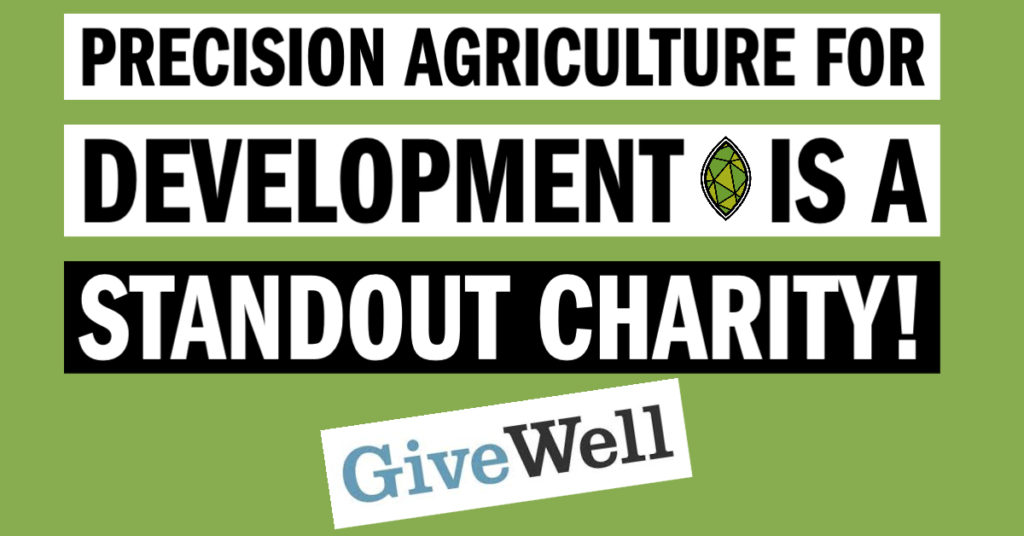
PAD was the ONLY new organization designated as a ‘standout charity’ in 2020.
We join eight other organizations in sharing this accolade. Taken together with the additional nine organizations on GiveWell’s list of ‘top charities’, PAD now ranks among the world’s eighteen most cost-effective not-for-profit development entities. This is an astonishing achievement!
It has been an unprecedented year: with the recent news of a large grant from an anonymous donor that will generously support multi-year plans to invest in research capabilities and practice, the breaking of ground on a multi-country collaboration with IFAD, and the addition of Nigeria as PAD’s 9th country of operations – PAD has already achieved a great deal this year; all in the crosshairs of an unprecedented public health emergency.
GiveWell is the world’s top research organization assessing non-profit cost-effectiveness, and is highly regarded for the rigor of their practice. Their endorsement of PAD is premised on a thorough evaluation of our work, and many hours of interaction with PAD’s development and leadership teams.
GiveWell concluded, based on their cost-effectiveness analysis, that their “best guess is that PAD’s program is approximately 6 times as cost-effective as GiveDirectly’s program, which provides unconditional cash transfers to poor households in low-income countries.” Moreover, the summary of their evaluation cites PAD’s “Unusually strong self-analysis, particularly in supporting RCTs on its program” and “Standout transparency. It has shared significant, detailed information about its program with us”.
GiveWell also highlighted that PAD needs to do more to demonstrate impact with rigorous evidence. The citation states that “New information could plausibly lead us [GiveWell] to believe that this program is as cost-effective as our top charities [the strongest designation GiveWell makes].”
This year has been challenging for all of us, in ways that were unimaginable less than a year ago. PAD has not only managed to largely take these challenges in stride, but has harnessed the disruptions unleashed by the COVID-19 pandemic to expand our scope and the depth of our programming.
Precision Development (!) will commence 2021 doing more, in more places, with more capacity and expertise, and more recognition.
We applaud the work of our colleagues! Carry on!
This year as we mark the International Day of Rural Women, Kara Czeczotka, PAD’s Senior Associate for New Program Development, canvassed some of our colleagues to highlight the unique challenges confronting rural women working in agriculture, and what can be done to more effectively empower rural women with information to improve their lives.
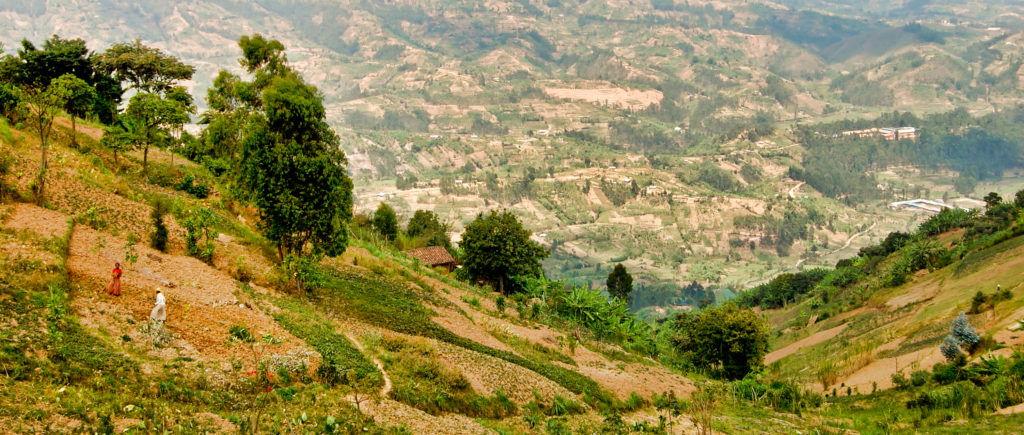
According to the United Nations, one in three employed women work in agriculture. In addition to unpaid domestic work and care that falls overwhelmingly on women everywhere in the world, women constitute 43% of the agricultural workforce in rural economies. However, women in farming households continue to confront unique challenges which constrain their agency, and contribute to rural poverty. These challenges include inadequate knowledge of, and access to, markets; limited decision-making power across all parts of the agricultural value chain; and constraints on their ability to influence or assert decision-making with regard to services, technology, and financial assets, which limits the ability of rural women to reap the full benefits of their labor.
As we mark the International Day of Rural Women in 2020, we are cognizant that these challenges are compounded and complicated by the impacts of the COVID-19 pandemic and the climate crisis, which – as with so many social and economic shocks – tend to hit women the hardest. “Globally, with few exceptions, every gender and development indicator for which data are available reveals that rural women fare worse than rural men and urban women and that they disproportionately experience poverty, exclusion, and the effects of climate change”. (UN 2020)
PAD’s COVID-related surveys of smallholder farmers in Kenya bear this out: As reported by my colleague Sam Strimling elsewhere on this blog, “Female crop farmers reported greater food insecurity than their male counterparts across several measures: compared to male farmers, female crop farmers reported that household members reported spending fewer days on their own farms and paying higher prices for fertilizer. Female crop farmers were also significantly more likely than their male counterparts to report that they had had to rely on assistance from family to cover living expenses and having to reduce the size or number of meals served in the 30 days prior to being surveyed.”
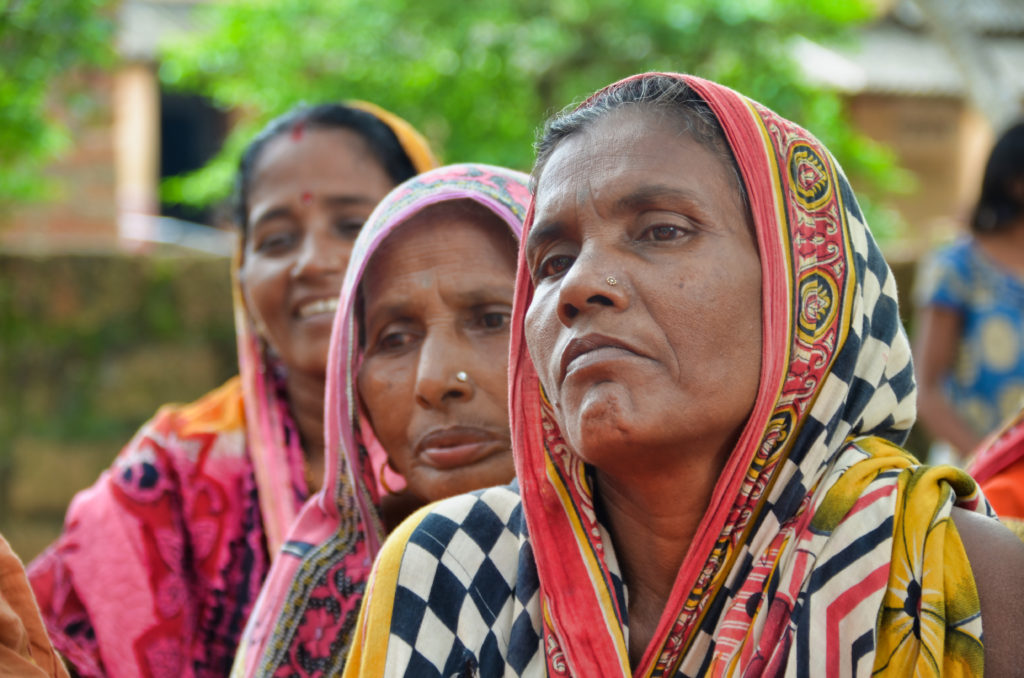
It is now more important than ever to understand how we can best respond and address the disproportionate impacts that affect women and girls across the globe. I am privileged to work with remarkable female colleagues who think a great deal about these issues. In this blog post, I have collated their reflections on challenges confronting rural women in smallholder agriculture, and the role PAD can play in addressing societal gender norms, utilizing digital information to empower rural women to be more productive, profitable, and to build more resilient communities.
How would you describe the role of women in agriculture in your country, and what challenges do these rural women face?
Farheen Sayam, Agronomist in Pakistan: In Punjab, women participate in agriculture in many ways, primarily with regard to the cultivation of major crops like rice and maize. Women contribute to sowing, hoeing and weeding, the application of fertilizers, picking of vegetables, harvesting crops, and also assume responsibility for almost all work related to dairy animal husbandry. Additionally, women are involved in poultry rearing, kitchen gardening, and the storage of grains for household use.
Viola Chemis, Dairy Specialist in Kenya: The participation of women in agricultural activities is mainly concentrated at the production level, the least profitable part of the value chain. Women are rarely involved in decision-making processes or leadership structures. Moreover, the vast majority of women do not own assets, such as agricultural land. This limits their investment options and access to finance. Women are also tasked with household work and production activities, including child-bearing, which takes up most of their time.
Deepa Manjanatha, Research Intern for India: Male farmers across Odisha (India) dominate access to agri-production resources relative to female farmers. This difference in access is strongly influenced by gender. This gender gap extends to decision-making power and access to farming knowledge, which is troubling considering the number of female farmers engaged in livestock and fishery farming in Odisha, and the social norms in place that perpetuate and preserve these gaps.
Kalkidan Arega, Senior Project Manager and Acting Director of Partnerships and Operations in Ethiopia: Ethiopian Women contribute as much as 70 percent of on-farm labor in post-harvest activities, for cereals, and make up 60 percent of the labor market. Women in agriculture engage in livestock and crop production, both for subsistence and for commercial use. Some survey results in Ethiopia show women are more involved in milking, processing and selling of milk and milk products (butter and cheese) and have also better decision-making in use and control of income from dairy products. However, marketing and decision-making over revenues usually falls to the role of head of the house, which happens to be the men.
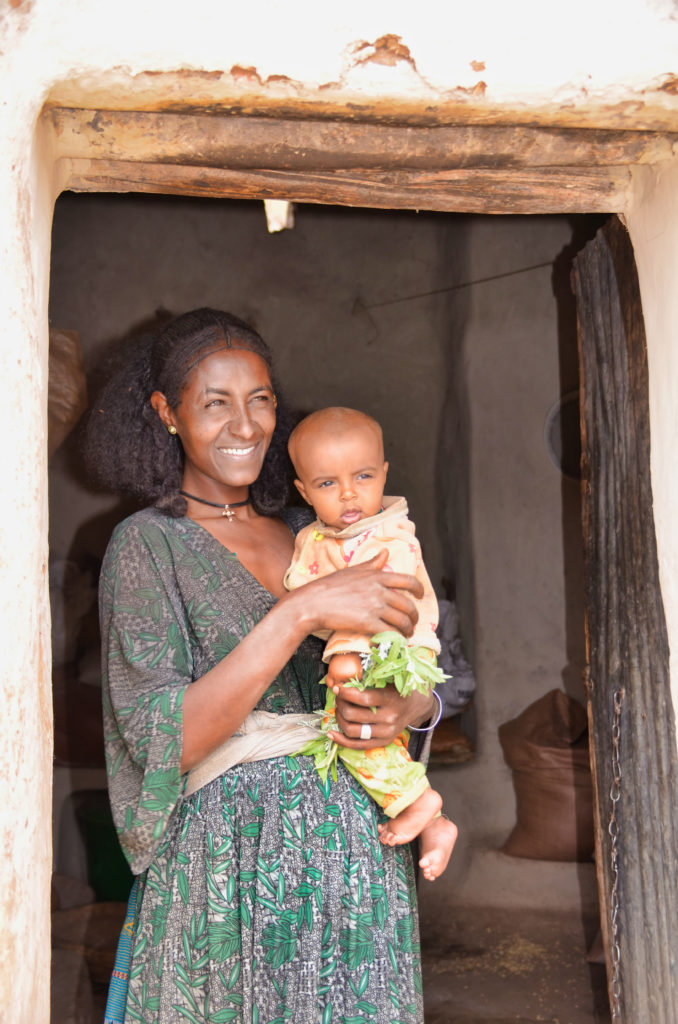
How do you think COVID-19 is impacting rural women relative to other populations?
VC: Rural women with young children overwhelmingly shoulder the responsibility of care for children who would otherwise be in school. Women with older children breathed a sigh of relief since the older children help with household and farm duties. However, with children remaining in the home, in many instances, household food budgets have increased. There have also been reports that more women are having to deal with managing abusive relationships or protecting their children from harm.
FS: Rural women in Pakistan confront escalated COVID-related risks because they lack awareness about COVID-19. This is because they generally do not have access to social media or other sources of information. Rural women aren’t always aware of good hygiene practices or about the relative nutritional value of different foods, and as a consequence, they may not be sufficiently informed to be able to take good care of themselves and their immediate family. Meanwhile, rural women in the milk or poultry business are also affected by economic shocks linked to a lack of transportation between rural areas and larger markets in cities due to lockdowns.
KA: Rural women engaged in informal businesses have been critically affected by restrictions due to the pandemic. In many instances vital social structures and systems are more constrained as resources and attention are refocused on the pandemic. This has contributed to a surge in extreme poverty. Rural women bear these burdens much more so than do men, with reported increases in trafficking and sexual abuse, among other abuses. There is also limited access to sexual and reproductive health services due to diversion of resources to cope with the pandemic.
What’s something surprising you’ve learned in your research or in discussion with female farmers?
DM: Despite the fact that women are engaged in many time-intensive tasks required for raising livestock, they often are not a part of the decision-making processes, animal care coordination processes, and/or financial transactions. Much of this seemed to be because women don’t have access to information on these topics and have traditionally been given tasks that are related more directly to caring for the livestock.
KA: During field visits it was surprising to speak to female headed households and see how knowledgeable they were on agronomic practices, and how eager they are to receive more information and training to learn more, even though there are low literacy levels.
In what ways do you think behavioral economics and digital agriculture can be used, or used more effectively, to improve the lives of rural women?
KA: Special attention should be given to digital advisory focused on women. Collecting better data on farmers broken down by gender will help us know the ratio of women farmers we are reaching and helping.
DM: By better understanding the perspectives of female farmers and women involved in agricultural value chains and the barriers faced by women, we can identify opportunities for closing gaps with technology, and more effectively develop programs that shift power dynamics in a way that female farmers feel comfortable with. It is important to pay attention to gendered barriers, social conditions and norms, decision-making power, task allocation and labor division, and the impacts of recommended practices on time and productivity.
FS: Leveraging technology and capabilities to provide training to rural women can create awareness about good hygiene practices and the advantages of eating nutritious foods (focusing on existing limited resources and providing information in their local languages), as well as awareness around cell phones, tablets, etc. Additionally, digital advisory can focus on support for existing supply chains that are disproportionately managed by women – such as organic kitchen gardening in Pakistan – not only for personal use but on a commercial basis.
VC: With a better understanding of gender dynamics, extension information can be refined and targeted to promote the inclusion of women along specific value chain development, and inform the development of gender-sensitive interventions and policy making.
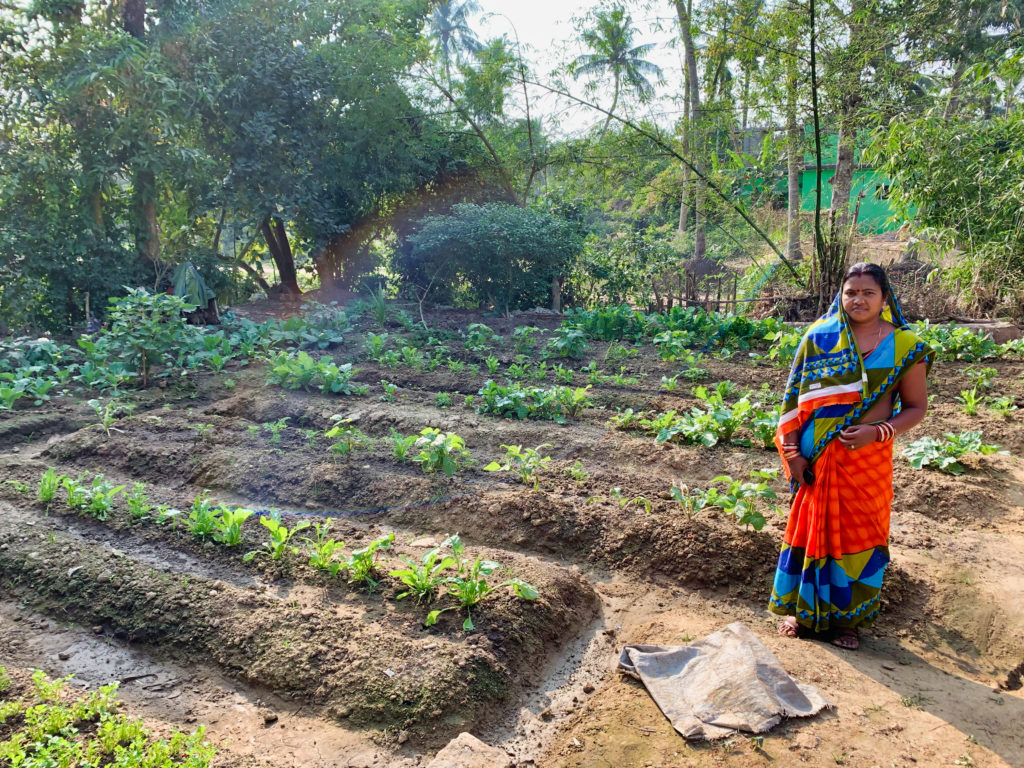
To understand more of PAD’s current research on the topic, I spoke with Theresa Solenski, PAD’s Research and Program Associate. Our research team is pursuing a number of cross-cutting initiatives to facilitate learning across teams and geographies on particular issues, such as gender and digital literacy. Theresa is leading research for PAD’s gender-focused cross-cutting learning initiative. In collaboration with Jessica Zhu (PAD Researcher) and Kaitlyn Turner (former East Africa Research Manager), Theresa has been engaged with thinking through what we as a team can learn from existing literature on gender in agriculture, with the ultimate goal of applying this to, and adapting, our services to better serve female farmers.
TS: Women in our countries of operation often provide 50% or more of agricultural labor, but have very little control over the monetary decisions or allocation. We want to make sure that women are equipped with the information they need to contribute to agricultural decisions, and have the ability to fulfill choices. This could be done by trying to do a better job at targeting women with content in areas in which women already have decision-making power.
One of our initiatives in India aimed to do just that. I learned more about the impacts of this initiative from Swetapadma Patra, PAD’s Senior Supervisor of the PADIF call center in Odisha, India. Sweta supported training for the kitchen gardens initiative that PAD piloted last summer. She noted how this service helped improve interpersonal relationships and skills development among female farmers exposed to the pilot. One impact she saw was “increased participation in decision-making for kitchen gardens, promoting inclusive growth intellectually, economically and socially.”
SP: Kitchen gardens directly contributed to household food security by increasing availability, accessibility, and utilization of food products. Food items produced in kitchen gardens also added to the family nutrition and diversification. The initiative improved women’s social status as well as their awareness with regard to the importance of a nutritional diet for their families.
How can we push ourselves to best serve the needs of rural women? We’re still learning and iterating as we go.
TS: When you’re providing women with agricultural extension services or trying to get them more involved in agriculture practices, you risk making them more time-poor. We want to be careful about giving women too much to do, on top of their other responsibilities. Consequently we focus on sending practical and simple advice that is most important for facilitating high value behaviors. One idea is incentivizing women to switch to higher value crops, and to provide them with information about market access and on how to sell the crops herself.
FS: Rural women lack access to new technologies. They need awareness facilitated through training and refreshers from various resources in the industry. The more the rural woman will be aware, the more she’ll be able to perform best, while improving earnings and autonomy.
VC: Women and children living in rural agricultural households dedicate most of their time providing family labour. By providing customized digital extension services, we anticipate it will contribute to the adoption of better farming practices leading to increased production, and subsequently, income. With the adoption of new technology and practices, it is my hope that it will reduce the time spent by women working on their farms.
DM: Ultimately, there is a lot to think about in this space and a lot to learn from female farmers in the field. By improving our understanding of their needs and their perceptions of the pain points they face, we could use our technology to make their lives easier, especially considering that female farmers/women in agriculture are often burdened with numerous other tasks and are generally time-poor to begin with. Technology can be leveraged to make their lives easier and to help empower them with information and resources they may not have been able to access without a technological intervention.
Interviewee responses have been edited for length and clarity.
PAD’s India Research Manager, Hannah Timmis, and Senior Research and Operations Associate, Maya Woser, reflected on lessons learned for the International Growth Centre’s blog
Otini Mpinganjira, Odisha State Lead, & Vineet Keshaw, Senior Implementation Associate, pay tribute to a remarkable team effort that has kept farmers informed in unprecedented times.
Precision Agriculture for Development’s Ama Krushi digital extension service was officially launched in 2018 with the ambitious target of reaching one million, predominantly poor, smallholder households in Odisha in just three years. Given the scale of the objective and the ambition of the delivery timeline, the culture of the Ama Krushi team is one that is accustomed to chasing down milestone achievements while adapting quickly to new challenges.
Generations of Odisha farmers have navigated challenges associated with drought and the cyclones that regularly rumble in off the Bay of Bengal. At the beginning of 2020, neither the Ama Krushi team nor the farmers we serve, could have anticipated the scale of the crisis associated with COVID-19, or the operational jiu-jitsu required of us to maintain – and grow – our digital extension service in the cross-hairs of the pandemic.
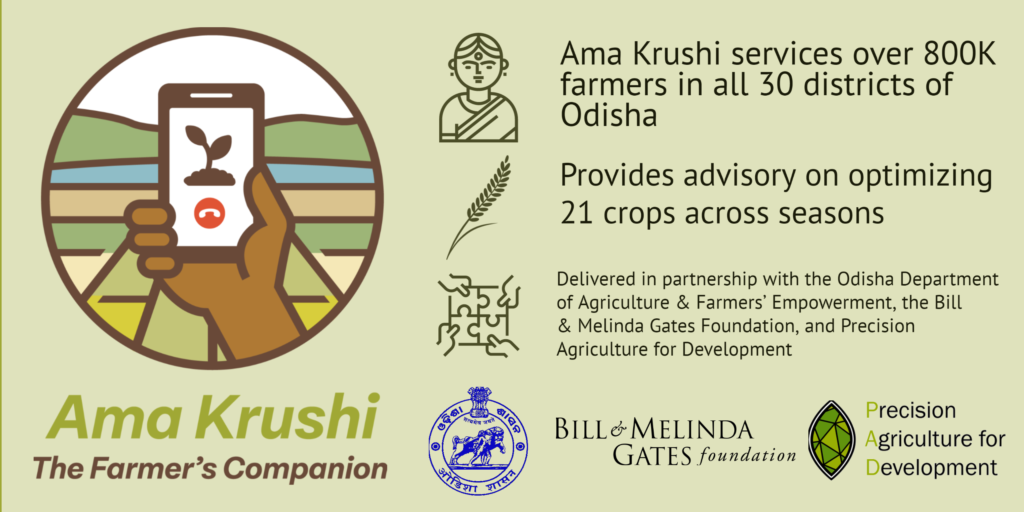
Two years along our delivery path, the two-way interactive voice response (IVR) system pioneered by Ama Krushi reaches over 800,000 farmers across all of Odisha’s districts. Our overarching task has always been clear: to deploy PAD’s iterative and human-centred approach to design, and to deliver actionable and impactful information to farmers via their mobile phones to secure and improve farmer livelihoods.
On a normal day (read: open office, no pandemic), a step into the programme office is welcomed with a buzz of activity akin to a lively bee colony: you hear the enthusiastic voices of approximately 100 call centre agents speaking to farmers handling a variety of tasks (onboarding new farmers, answering queries, coordinating remote training and remote surveying etc.). This buzz is contrasted by the soundproofed quiet of the content generation space with its pristine white walls and our team of agronomic experts going about their work responding to farmer queries or recording new messages.
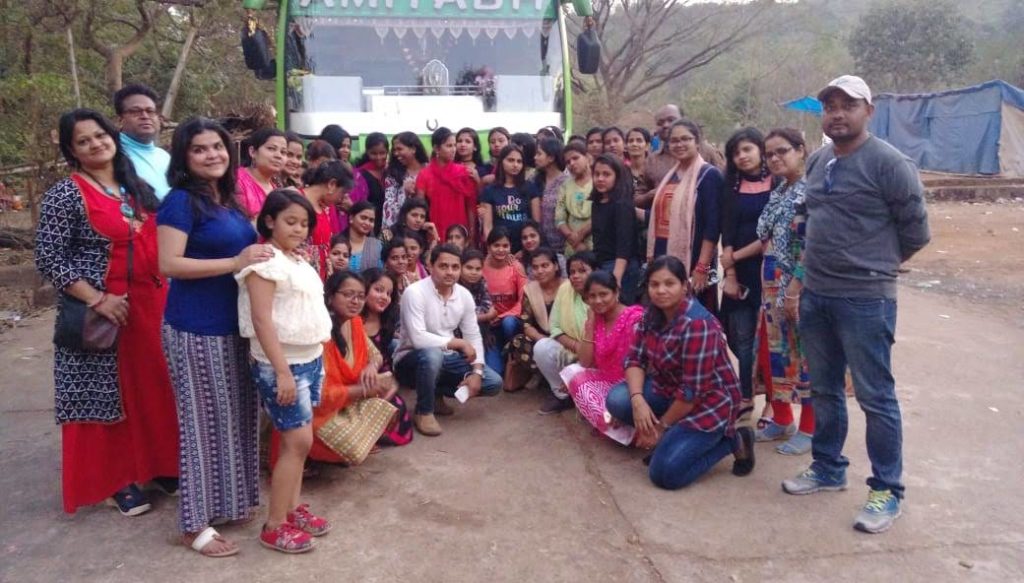
Aah, the good old days! As is now commonplace across the world, the situation today is very different to “normal”. However, one shouldn’t be too nostalgic. In normal circumstances, the smallholder farmers we serve face a level of information poverty that perpetuates a cycle of hunger and inhibits economic opportunity. By limiting physical interactions and affecting supply chains, the current pandemic has the potential to exacerbate this information gap; further escalating the precariousness of smallholder livelihoods.
PAD and the Ama Krushi team in Odisha have worked tirelessly to ensure minimal disruption to our services. Safety first!. Our highest priority was to ensure the safety of the team and our farmers. While the office was still open we swiftly implemented best practices to optimize hygiene, introduced a regime of regular disinfection for shared and commonly regularly used surfaces, provided hand cleansing facilities in all workspaces, and adjusted sick leave policies.
As the effects of the pandemic worsened and it became obvious that lockdown measures were imminent, the team worked to define a set of critical activities, and identified the complementary technologies and protocols that would be required to keep the programme operational as staff began working from home. Critical services and activities were identified as follows:
- Farmer Onboarding: Continued profiling and onboarding would ensure that new farmers could continue to join the service. In the context of the lockdown, onboarding farmers became more urgent as many farmers lost all other sources of information in the aftermath of agro-dealers being shut, and agricultural extension workers becoming unavailable due to the lockdown. The deep-dive in Box 2 below details the journey to moving our call centre operations to remote working status. Between April and June 2020, Ama Krushi successfully onboarded just over 106,000 new farmers.
- Content Delivery: Notwithstanding the well-documented advantages of digital extension services (cost-effectiveness, scalability, hugely favorable benefit-cost ratios, etc), a key advantage of digital advisory services during the current crisis is that information can be delivered via mobile phone without risking the health of farmers or extension workers. Delivering content would ensure that farmers registered on the service would continue to receive their weekly advisory messages. By happenstance, lockdown measures were imposed at an important transition point as farmers moved from harvest and crop storage activities following the winter season (Rabi), to preparation activities ahead of the summer season (Kharif). In addition to our regular agronomic advisory, Ama Krushi was well-placed to ensure that farmers were able to receive information alerts related to the lockdown. Overall, between April and June 2020, the service sent over 5.6 million outbound messages on a variety of topics (e.g. disease and pest management, harvest management, lockdown related advisories etc.).
- For example, on 15th & 16th April, Ama Krushi issued an advisory to ensure that farmers were aware that they could still take their produce to market (see Box 1, below)
- Similarly we distributed content related to the onset of the Kharif planting season, informing farmers that they could initiate cultivation.
BOX 1: Examples of messages sent during lockdown
“Namaskar. Welcome to Ama Krushi, the free Agriculture Information service of the Department of Agriculture, Government of Odisha. Some special information for farmers: Farmers who are harvesting a variety of vegetables this Rabi season can take their produce to the nearest agricultural market for sale. There is no barrier to transporting your products. Contact your nearest agricultural officer or horticultural officer for this.”
“Namaskar. Welcome to Ama Krushi […] Some special information for farmers: The current Kharif season has begun. At this time, farmers can cultivate their own land despite the coronavirus shutdown. You can use your own or rent agricultural machinery. Contact your nearest agricultural officer or horticultural officer for more information.”
- Farmer Helpdesk: We also needed to ensure the continued operation of our automated inbound service; i.e. to allow registered farmers to continue to call in and record questions 24/7. Our Live Call Centre (LCC) service, where farmers speak directly to an agent, saw a three hour extension in operating hours to assist farmers during a period of heightened need. Our partners at the Department of Agriculture & Farmers’ Empowerment (DAFE) actively promoted the LCC service through television and print media resulting in a 500% increase in traffic. For all inbound calls, our team applies tags which allow us to categorise the nature of a question and to link it to answer in our answer library. For lockdown operations, we introduced new tags to track issues related to the lockdown, as well as to ease the summarizing of data pertaining to the preparation of daily reports for DAFE and other policy makers. The team took the extra step of forwarding particularly complex queries to district nodal officers with the intention that they follow up with complementary advice in person on the ground. This was achieved in collaboration with members of the Analytics for Decision-making and Agriculture Policy Transformation (ADAPT) team; a sister project also working with DAFE. Between April and June 2020, the LCC received just over 24,000 calls primarily related to government schemes, market registration as well as pest and disease management.
- Research & Development: To more systematically understand the evolution of the pandemic and its local impacts, our research teams quickly developed a survey tool.
BOX 2: Moving a 100 person call centre to remote work
By design, the Odisha programme uses a call centre model to onboard (profile) farmers. The model has various advantages for data quality and resource effectiveness. In solving the problem of building remote call centre functionality, we borrowed heavily from tools under development in the technology pipeline. Over a 2 week period, we then worked to re-purpose them for the needed functionality. The main challenge was how to enable our agents to use a combination of feature-phones and smartphones to make and receive calls while maintaining some of the quality assurance protocols that we had in place. The other challenge was logistical; i.e. ensuring that agents had access to mobile phones and SIM cards, that we had an efficient and secure way of delivering farmer numbers and that we could train them on use of the new systems.
To test our solution, the team launched remote profiling at 25% of our operating capacity. At the same time, we introduced a back-check model to substitute our previous monitoring system. Our technical team made the requisite changes to ensure secure access to farmer’s details. The new home-based profiling system was not only customized to enable our staff to access it from their mobile phones, it also integrated a range of functions appropriated from the dialer system we use when working from the office, including the following additional functions:
- Sample selection: It automatically provides farmer details to survey agents.
- Call status: Survey agents are able to submit call status which helps to maintain the call log and the overall monitoring system.
- Incoming call: One of the biggest issues survey agents faced was not being able to record the details of farmers who call back. To assist with this challenge, we implemented changes to enable survey agents to profile and note the number of incoming calls.
- Survey agents activity: Surveyors can access their performance indicators, i.e. calls made, the number of farmers profiled over a month, a week and on that particular day.
- Training: To train our survey agents, we implemented a remote training solution utilizing video conferencing.
Given the scale of the challenges arrayed before us, and the emerging needs of our famers, we have of course experienced many challenges, including technology not functioning as intended to connectivity issues affecting output. We also continue to be engaged in a battle to shift our collective mindsets to maintain productivity as we work from home, and while we balance domestic duties and distractions.
As the Kharif season moves into gear and as we come to terms with the long-term nature of the pandemic, we have started to prepare more proactively for the future.
Normalisation is the key word here. Through downshifting, we are faced with the challenge of empowering execution staff to own – as they did before – the majority of day-to-day call centre functions. This will include training them on the tools that our project managers have been using to manage our remote call centre functionality as well as providing them with checklists and avenues for assistance. This will allow us to dedicate project management resources and capabilities to reintroducing deprioritised, but nevertheless important, components of the programme such as manual feedback surveys and remote farmer training.
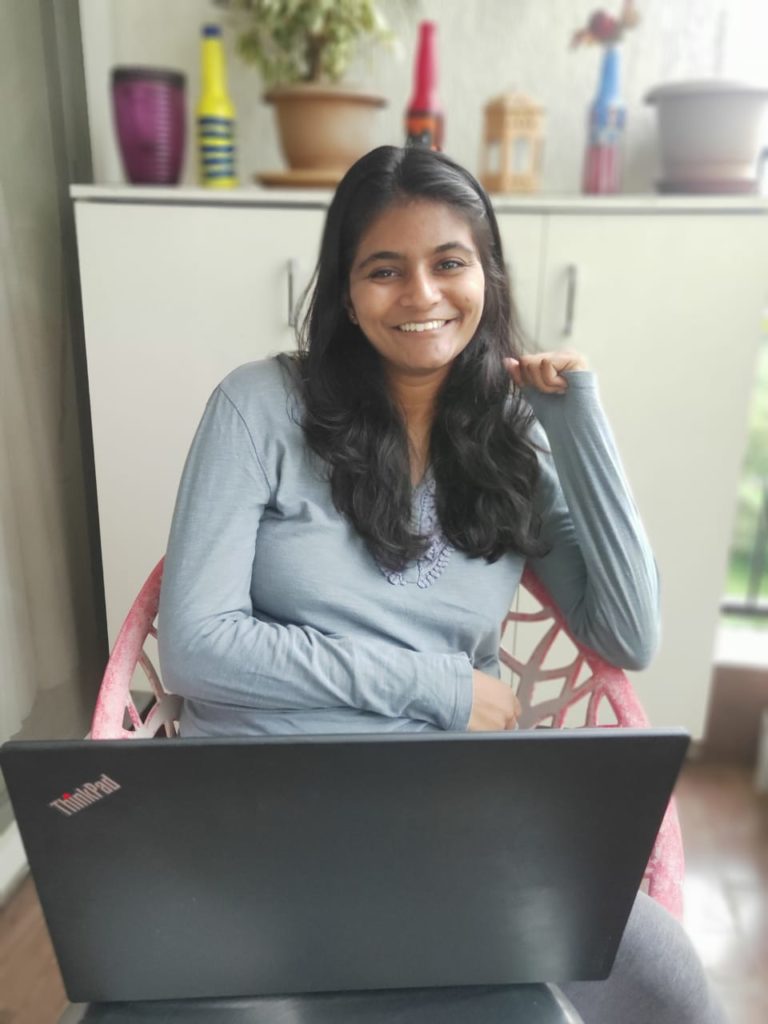
We are immensely proud of the work of the Ama Krushi team. Through flexible application of technology, a get-stuff-done mentality, and the enduring spirit of this team, our service to farmers never stopped… Not even for a day.
From the survey agents and agronomists who showed their willingness to work from their home, despite many having to do so in circumstances that are far from ideal, to the supervising team who stayed on top of teething issues and provided valuable input when necessary. This has been a huge collective effort . An unavoidable cost of work-from-home arrangements is that not all jobs can be done from home. Similarly, some roles may become more peripheral as priorities are realigned. It has been heartwarming to note the care the team has extended toward one another. One example is the contributions drive organised towards a fund for our security guard, who due to mobility restrictions, was unable to return home to his family for several weeks.
As a team – spurred by a crisis or two – we have learnt the value of purposeful and early communication as a tool for establishing a common baseline understanding for everyone to work from, and the need for maintaining connections across the wider team. We have reaffirmed our shared mission to empower smallholder farmers, and despite not being together, we have worked together to keep the programme running.
We thank our partners at the Department of Agriculture and Farmers’ Empowerment for accommodating and supporting our work from home initiatives throughout this period.
Ama Krushi is on track to empower one million smallholder farming families ahead of schedule. None of us could have imagined the conditions in which we strive to reach that milestone, and pilot new projects targeting livestock and women farmers, as we continue to iterate and add more value to the service.
MoA-INFO has rapidly developed new capabilities and widened its scope to more effectively serve Kenya’s smallholder farmers. PAD’s Africa Regional Director, Emmanuel Bakirdjian reflects on the first two years of MoA-INFO’s operations.
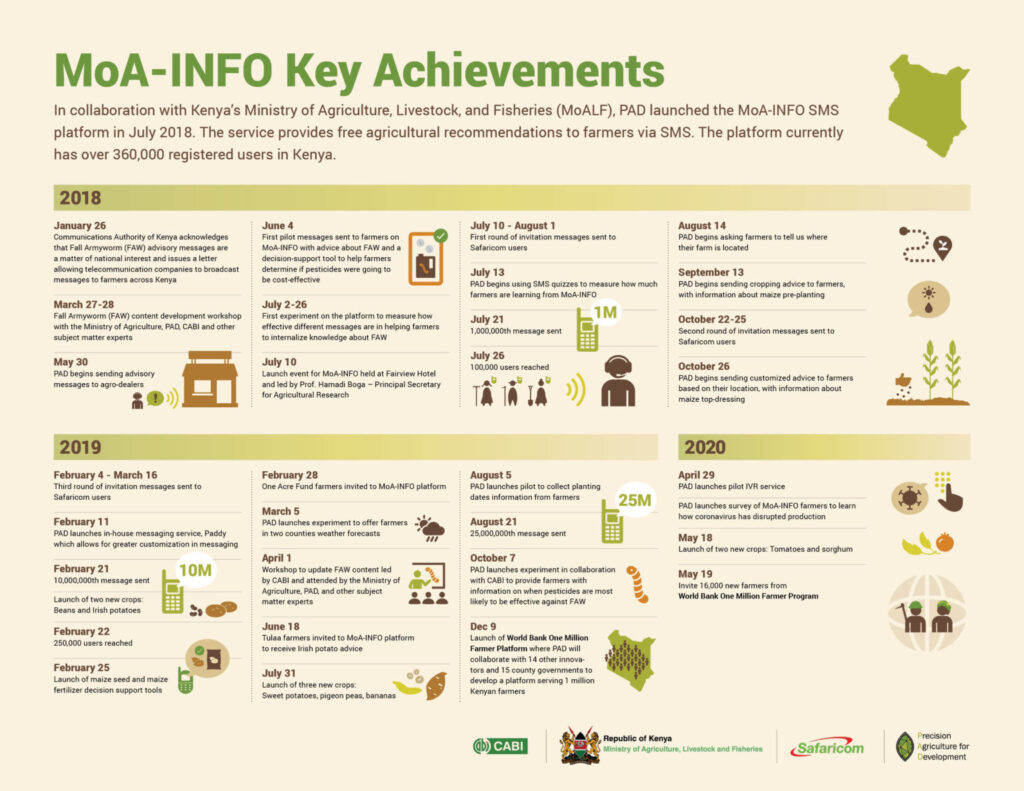
This month marks the second anniversary of the launch of MoA-INFO, Precision Agriculture for Development’s flagship service in Kenya. In just two years, MoA-INFO – which we deliver in partnership with the Kenyan Ministry of Agriculture, Livestock, and Fisheries (MoALF) – has developed from a relatively simple one-way information advisory system, into a set of dynamic, mutually reinforcing, two-way communications tools which empower farmers to make informed agriculture choices across a range of decision points.
The service has grown in scope and reach since it commenced operations with 20,000 farmers in the second quarter of 2018. To date, MoA-INFO has cumulatively serviced more than 420,000 farmers across all of Kenya’s 47 counties. Initially, the platform focused on dispensing advice focused on combating an invasive pest, Fall Armyworm (FAW), but has been expanded to include recommendations on eight subsistence and cash crops and a range of associated pests and diseases. These include (as of July 10th, 2020): maize, beans, Irish potatoes, sweet potatoes, bananas, pigeon peas, tomatoes, sorghum. The system delivers customized advisory, in either English or Swahili, tailored to a farmer’s location and agro-ecological zone. The service is entirely free to farmers and can be accessed from any type of phone.
Farmers can register on the service by texting the word ‘FARM’ or ‘SHAMBA’ to 40130, to receive messages in English or Swahili, respectively. Users can change the language of the service at any time by texting the instruction ‘ENGLISH’ or ‘SWAHILI’. Farmers can access information by texting ‘MENU’ (‘ORODHA’ in Swahili), and can access the FAW monitoring tool by texting the word ‘CHECK’ (‘ANGALIA’ in Swahili).
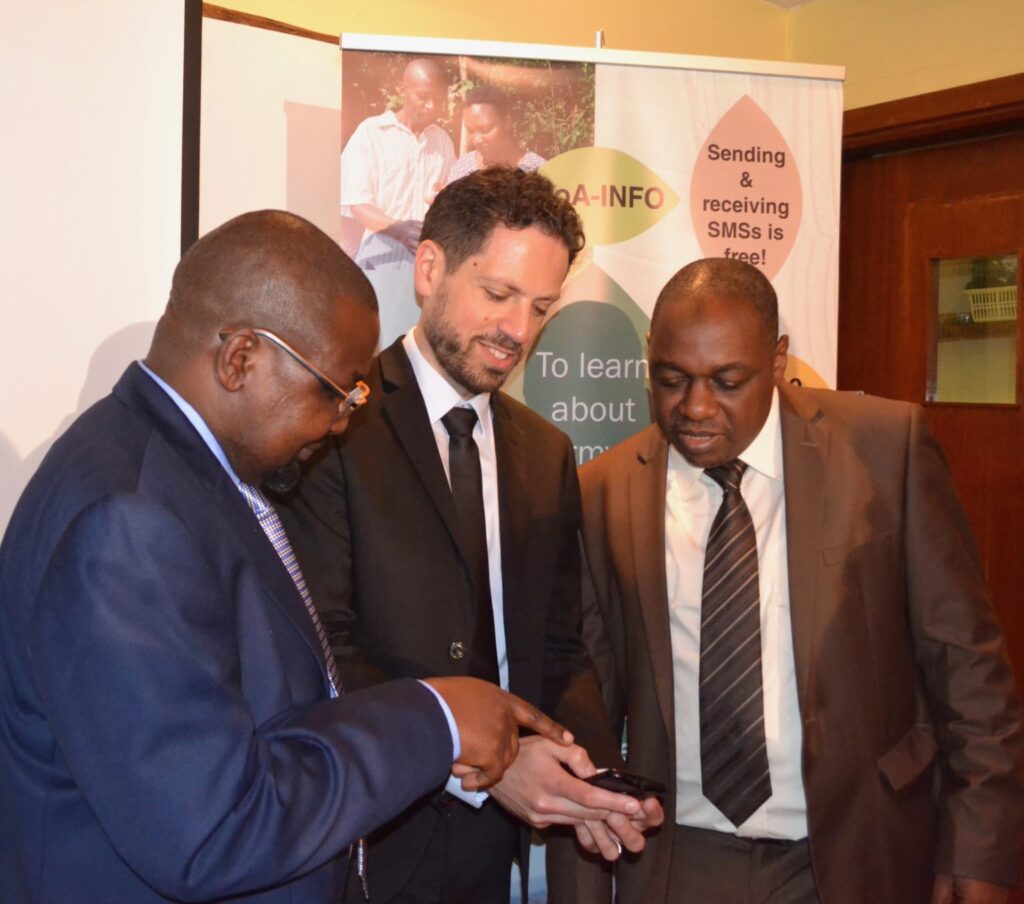
All advisory content is based on recommendations jointly developed with technical experts at the MoALF (including KALRO, the Kenya Agricultural and Livestock Research Organization). The service allows farmers to both pull content, when they are looking for information about crop production or pest control, and receive push messages containing information about farming practices that are timed to coincide with cropping schedules in different parts of the country.
The service also provides farmers with Decision Support Tools (DSTs) to help farmers make evidence-based decisions. PAD has developed tools to help farmers decide on which maize seeds to plant, which fertilizers to apply, and whether pesticides are appropriate based on the scale of pest infestation. Using a farmer’s location, MoA-INFO asks the user filter questions – such as their land size, budget and preferences – and then provides them with recommendations for inputs and practices based on their responses.
Since the launch of the platform, we have run dozens of A/B tests to generate evidence to allow us to improve the design of the service. For example, we have leveraged the results of A/B tests to optimize the way in which we ask farmers for their location, to more effectively encourage farmers to refer peers to the platform, and to improve the way in which we ask farmers about their language preferences on the platform.
We have also used A/B tests and other rigorous research methods to measure the impact of the platform. We have run five A/B tests evaluating the effect of push messages on farmers’ knowledge about FAW using a combination of SMS and phone surveys. In a separate experiment, we partnered with the Centre for Agriculture and Bioscience International (CABI) to test messages leveraging weather modelling to inform farmers about the appropriate application of pesticide tailored to their location. In two of the six trials, farmers were statistically more likely to answer quiz questions correctly than farmers in the control group who did not receive the push messages. Using meta-analysis, we have found that, on average, farmers who received the MoA-INFO messages answered 5% more questions correctly than those who did not. Lastly, trials conducted with CABI and One Acre Fund, respectively, demonstrated that SMS messages increased the self-reported likelihood of adopting recommended practices by 5 to 23%.
As we press ahead, we look forward to continuing to serve smallholder farmers in Kenya with quality, customized, and actionable information. We will continue to expand the platform, both in terms of its reach and its content to support as many farmers as possible with critical and empowering information. Lastly, we want the platform to continue to be an effective tool that is available to the Ministry of Agriculture, and other partners, capable of responding rapidly to new threats confronting farmers, and to help them mitigate new risks as they arise.
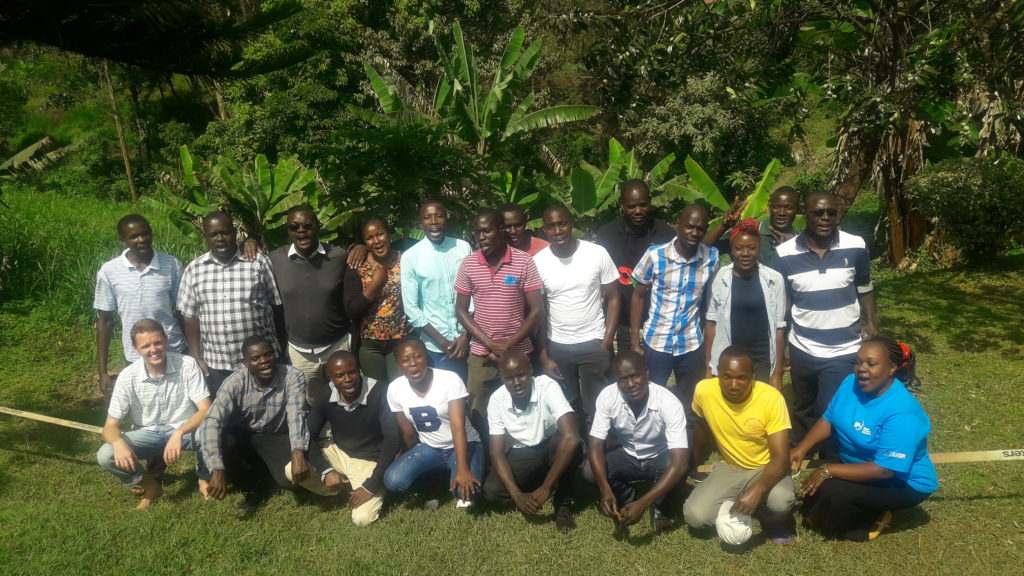
I am immensely proud of what the PAD team has achieved in such a short period of time. Our work has been empowered by the quality of our partnerships with MoALF, KALRO, CABI and Safaricom which have enabled us to scale and iterate so efficiently. In particular, I want to thank Prof. Hamadi Boga, Principal Secretary of the State Department for Agricultural Research in MoALF, who officially launched the platform two years ago. Prof. Boga has been a tireless advocate for the platform, and has promoted and advertised the shortcode number and keywords at multiple conferences and in his interactions with farmers. We look forward to continuing our work with Prof. Boga and his team.
For any questions or comments, please feel free to reach out to us at kenya@precisionag.org.

How does one empower smallholder farmers during the COVID-19 pandemic? Jonathan Lehe – PAD’s Chief Development Officer and Director of New Programs – reflects on the powerful advantages of digital information systems in a context of crisis, and how acting now will lay a foundation for future development.
Before the COVID-19 pandemic brought the world to its knees, I was eagerly awaiting the 12th ICT4D Conference which had been scheduled to take place in Abuja, Nigeria in April. As with so many aspects of our lives that we have had to adjust to protect ourselves and our communities from this virus, the ICT4D Conference had to adjust, and went virtual.
As part of the virtual conference, I had the pleasure of participating in a webinar on the topic “Supporting Farmers with Low-Cost Digital Tools During COVID-19” where I spoke about the work PAD is doing to support smallholder farmers during the pandemic. The webinar turned out to be a great success, and unwittingly demonstrated how digital technology can provide innovative solutions to overcome some of the adverse effects of this crisis, and showcased how digital channels can make information accessible to a wider audience, far beyond the lucky few who would have been reached in person.
Smallholder farmers are among the most vulnerable populations in the world, and are particularly vulnerable to negative shocks associated with this pandemic. We believe that digital information services are particularly well-placed to help farmers respond to the pandemic, for several reasons. Digital services:
- do not require face-to-face contact with farmers, and can be maintained at a time when in-person services are impossible;
- are highly scalable – PAD’s services reach 3.6 million farmers in eight countries around the world;
- are cost-effective – PAD’s advisory services cost just $1.55 per farmer per year, on average;
- are available on demand;
- democratize access to information – reaching farmers with the simplest feature phones, no data coverage, and limited digital literacy, and those in many hard-to-reach, fragile, or conflict-affected settings which traditional extension cannot reach;
- enable two-way communication, so we can gather real-time data from farmers;
- can be highly customized and tailored to users’ needs; and
- can be continuously iterated and improved in real-time.
These features are particularly valuable in an emergency situation when conditions on the ground change rapidly.
To respond to COVID-19, PAD is adapting and broadening our digital information services to meet farmers’ evolving needs:
In Kenya, where traditional extension has been completely disrupted, our MOA-INFO platform, which we implement in collaboration with the Ministry of Agriculture, remains fully available to the 360,000 farmers it serves, and is expanding to include advisory content on three new crops. This platform was originally designed to respond to a different emergency – the Fall Armyworm outbreak which ravaged Africa in 2018 – and from its inception was designed to facilitate a two-way flow of information and adapt rapidly to farmers’ needs.
In Uganda, where PAD is conducting research comparing in-person and digital extension in partnership with TechnoServe and HRNS, in-person training has been halted entirely due to strict social distancing protocols. Unaffected by restrictions on human movement, PAD has stepped in to provide comprehensive digital advice to smallholder coffee farmers. We have also adapted our service to provide COVID-19 advisory content based on the Ministry of Health’s official recommendations, including a description of common symptoms, how to avoid spreading the virus, and how to get additional information.
In India, while traditional extension has been suspended, PAD’s digital services have remained open, and continue to serve 830,000 farmers across six states, while adding thousands of new farmers to the platform each month. In addition to our existing services we are expanding our advisory content to address several critical new information gaps in response to COVID-related market disruptions. In many cases, we collect crowd-sourced information from farmers, triangulate this information using multiple farmer data sources, validate it with a subset of farmers to ensure its accuracy, and inform farmers about its source when we disseminate it. Crowd-sourced information about which markets remained open, which crops are sold on what days and at what prices, and which agricultural activities are exempt from lockdowns may change from day to day, so having access to real-time information can be enormously useful to farmers. Other types of new content include how to produce organic inputs while markets are inaccessible, and how to store crops that cannot be sold at markets.
In a crisis like this, gathering systematic and reliable data on challenges confronting rural populations can be difficult. PAD has built and maintains a large user database of farmers spanning eight geographies on two continents. This provides us with real-time feedback we can use to rapidly understand and respond to shifting needs as the pandemic evolves.
PAD is conducting a multi-country phone survey of farmers, agro-dealers, and extension workers in Kenya, India, Pakistan, and Uganda to rigorously understand the pandemic’s impact. We are collecting data on a wide range of agricultural market disruptions, including farmers’ access to input and output markets, food security, price changes, income loss, migration, and other adverse events. We are also collecting health-related data, including farmers’ knowledge and perception of public health messages, and adherence to recommended behaviors such as hand washing and social distancing.
Looking ahead, PAD is working on several new digital tools that can be rapidly deployed to help farmers respond to market disruptions. Building trust with our users during more normal times enables us to quickly adapt and provide valuable new services. For example, we are creating a vetted database of agro-dealers and output buyers, and connecting farmers with these intermediaries so that key services are not interrupted. As mentioned above, we are aggregating and disseminating crowd-sourced market information to farmers, including crop prices which are fluctuating more than usual. We are also expanding our services to include COVID-specific health information, such as disseminating public health campaigns on hand washing and social distancing. User-centered design and A/B testing, which are deeply embedded in our services, are especially valuable in this rapidly changing context. For example, A/B testing can be used to rigorously determine the optimal way to deliver public health messages to maximize their influence for changing behavior among rural populations.
Digital agricultural extension is a scalable, cost-effective solution that helps more farmers access actionable information. Digital tools are an important complement to traditional extension services even when in-person extension is available. In an emergency context, when traditional in-person communication channels are impossible, investing in low-cost digital tools to get farmers the information and market linkages they need, to gather real-time information on the challenges on the ground, and to adapt these tools to address these new challenges become urgent priorities. Just as the ICT4D webinar provided me with an opportunity for open dialogue with hundreds of development practitioners across dozens of countries without having to leave my living room, digital agricultural extension is already helping millions of farmers around the world access the best agricultural expertise and advice from the palm of their hand. Investing in digital agriculture now will not only empower farmers to weather the COVID storm in the short term by supporting farmers’ livelihoods and food security, it will also accelerate the long-term transformation of agricultural extension systems and lay the foundation for advances in rural development long into the future.
We have just tied the bow on our final quarterly report for 2019. In the full calendar year Precision Agriculture for Development (PAD) served 3.5 million farmers, assisting some of the poorest people on our planet to increase their farm yields and incomes for the benefit of themselves and their families.
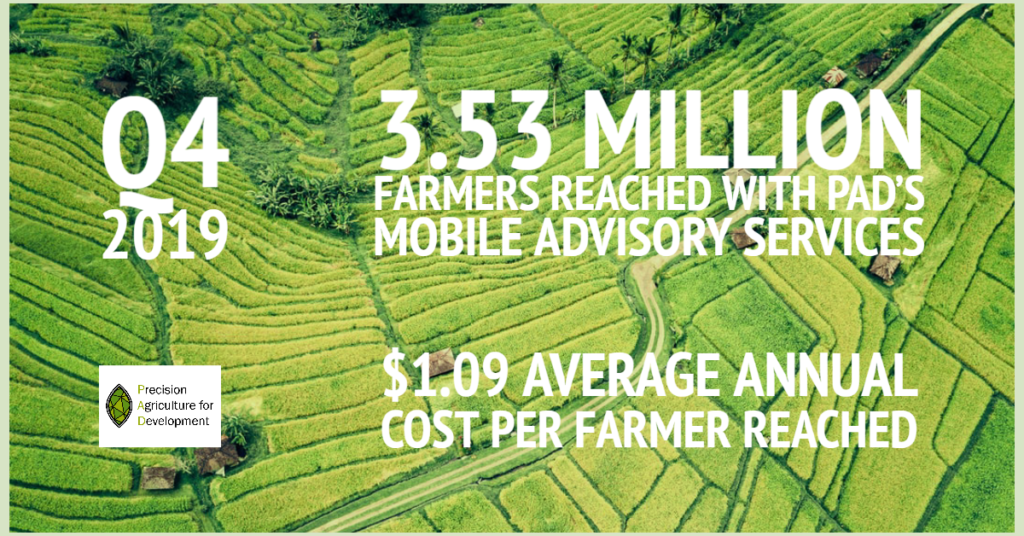
PAD has grown far more quickly than we dared hope in our strategy written just two years ago. As we grow, we are coming to terms with the fact that we are no longer just a start-up. We want to maintain our plucky, can-do and nimble mentality. But we are also in the process of putting in place the governance, structures and systems that enable us to deliver effectively at scale. One component of that has been the appointment of Amrita Ahuja to our board. Amrita brings to our leadership collective a wealth of experience and expertise, and unique insights into scaling evidence-led development interventions as a co-founder of Evidence Action.
PAD is dedicated to learning through rigorous research, but also by learning as an organization, and as a team. Our Q4 2019 report includes open acknowledgement of challenges and setbacks that we have encountered. We know that there are opportunities to learn in moments of frustration, and in instances when we must take two steps back before, again, moving forward. I hope that being frank about challenges, and learning from them, will be a feature of our reporting and communications going forward. (As we move towards being open about where things have not gone as we had hoped, I am reminded of the wise words of the fictional Sir Humphrey Appleby in Yes Minister, who tells Ministers that a decision is brave if it will cost them votes, and courageous if it will cost them the election).
In Q4 2019, PAD began operations in Zambia, our eighth country. These are exciting times for all of us at PAD. Many hands have contributed to our success. We hope more will join us as we reach more farmers in more geographies in 2020.
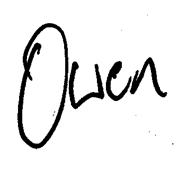
Owen Barder
Chief Executive Office, Precision Agriculture for Development

Listen in to our CEO, Owen Barder, and co-founder, Michael Kremer, discuss PAD’s use of mobile technology to empower smallholder farmers with actionable information on the BBC’s Digital Planet program.
#TeamPAD is living its bucket list in Sverige.
Our co-founder, and PAD board member, Michael Kremer is in Stockholm to receive his Nobel Memorial Prize in Economic Sciences together with his co-laureates, and longstanding collaborators, Esther Duflo and Abhijit Banerjee.
Fellow board members Shawn Cole and Amrita Ahuja, as well as Owen Barder (PAD CEO), Tomoko Harigaya (Chief Economist and Director of Research), and Carol Nekesa (Chief People Officer) are in Stockholm as Michael’s guests for the festivities.
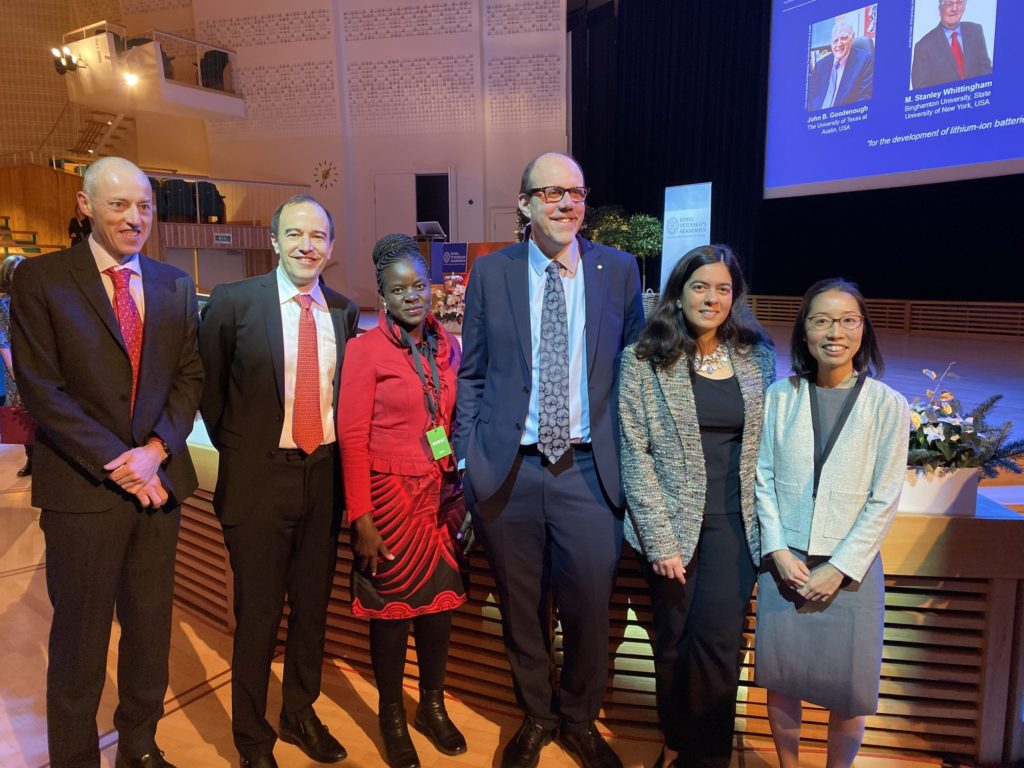
Oh yes, and lest we forget, PAD was name checked in Michael’s Nobel Lecture:
“The spread of mobile phones, the availability of large data sets and the development of machine learning are opening up tremendous opportunities for digital development in areas from education to agriculture…
Precision Agriculture for Development, an NGO which I helped co-found, is now working with governments and private firms in multiple countries to provide digital agricultural extension to millions of farmers.
This is just the beginning. We need to encourage a variety of new approaches to take advantage of new opportunities, test new approaches, refine them and scale up the most effective solutions.“
[at 27.54min in the video above]
And it’s only Monday! Prize giving is on Wednesday. Have fun all!
Precision Agriculture for Development (PAD) is humbled to share the news that our co-founder and board member, Michael Kremer, is a 2019 Nobel Laureate for Economic Sciences.
In announcing the award, the Nobel Committee stated that Michael Kremer and his co-laureates Esther Duflo and Abhijit Banerjee have “considerably improved our ability to fight global poverty. In just two decades, their new experiment-based approach has transformed development economics, which is now a flourishing field of research”.
Unsurprisingly, Michael has insisted that this is an award shared by everyone who works in evidence-based public policy and research.
At PAD we are privileged to work with Michael in harnessing the power of technology, data science and behavioural economics to provide targeted information to farmers in developing countries to improve their lives. Our collective work would not be possible without the support and collaboration of our partners.
Read the full press release here
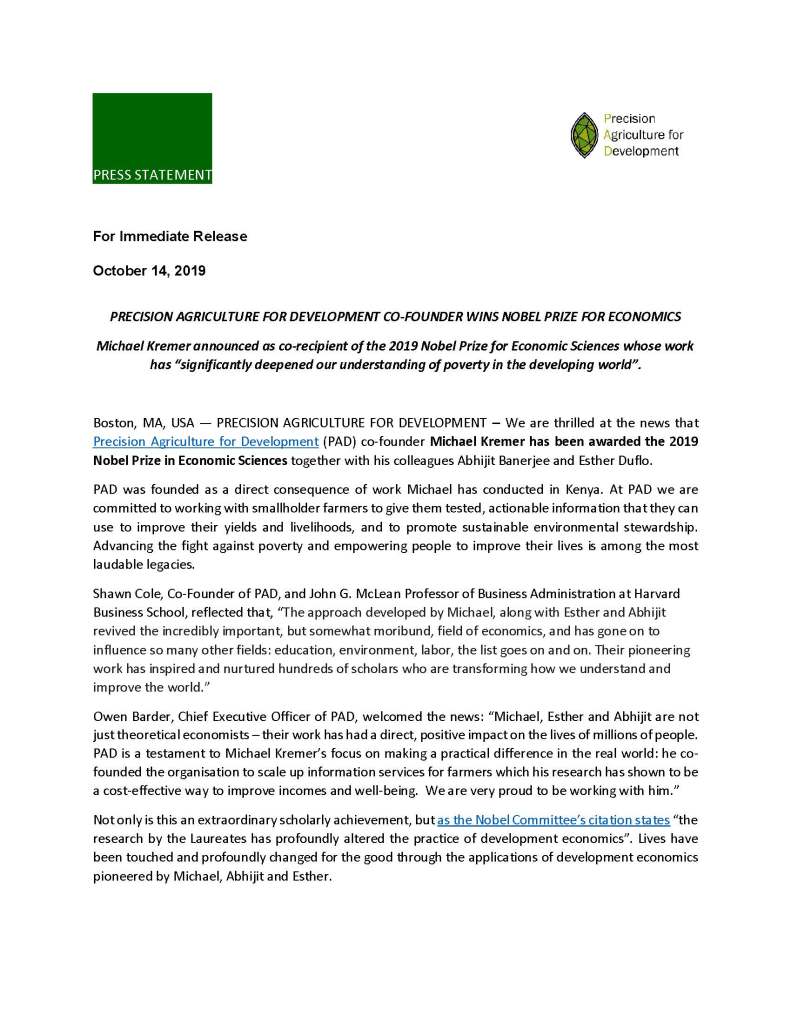
Make an Impact Today

